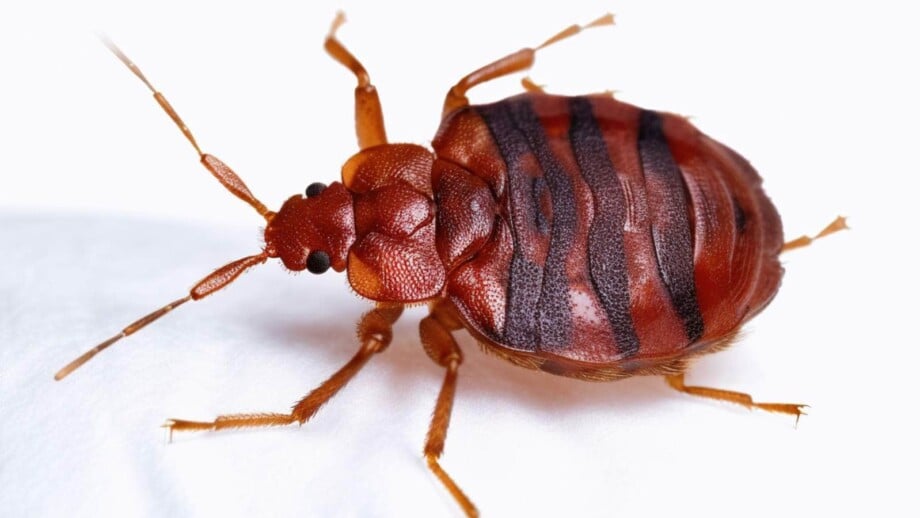Bed bugs – just the thought of them can send shivers up the spine. However, they can be notoriously tough to spot. In this guide, we’ve shared bed bug pictures and images to provide you with a magnified view of what bedbugs look like at different development stages, and locations, and also compared bites to other insect bites.
This page is crucial because early detection of a bed bug infestation can stop the spread and development of an infestation. Throughout their five stages of development, as well as before and after a meal, bed bugs exhibit a variety of appearances that can make identification more challenging.
To make such identification much simpler, we have put together the bed bug images below.
You’ll also find bed bug bites pictures and bed bug pictures in various settings around the house to help identify them correctly.
Adult Bed Bug Image
Below is a close-up image of an adult bed bug.
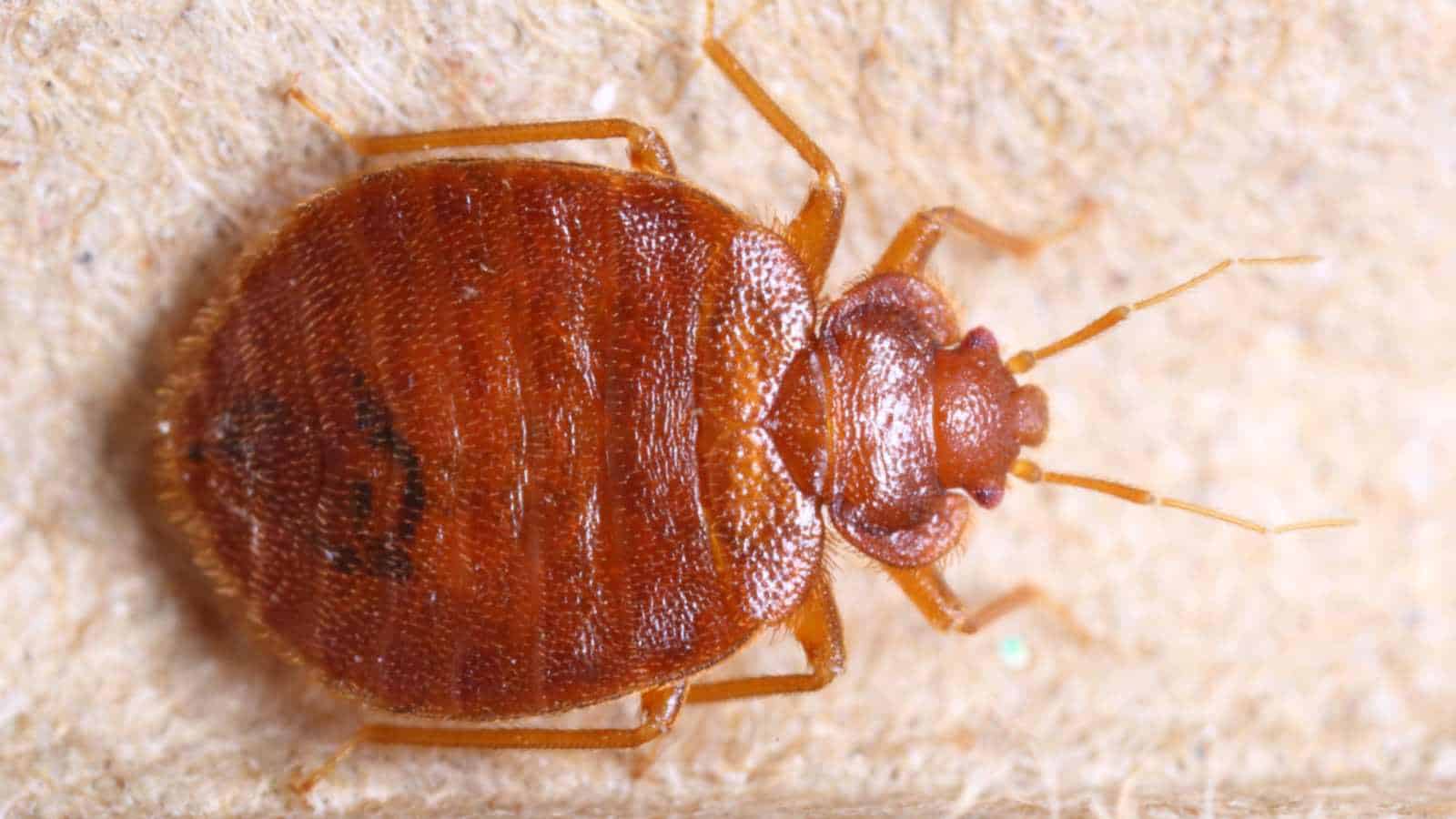
An adult bed bug, when viewed up close, reveals a rather small, oval-shaped insect with a flattened body. Its size typically ranges from 4 to 5 mm in length, which is roughly the size of an apple seed. The adult bed bug’s body is segmented into three distinct parts: the head, thorax, and abdomen.
The most noticeable feature of an adult bed bug is its reddish-brown to mahogany coloration, although it can appear more reddish after feeding. The exoskeleton of the bed bug is semi-translucent, which allows you to observe its internal structures, like its digestive tract, when it has recently fed.

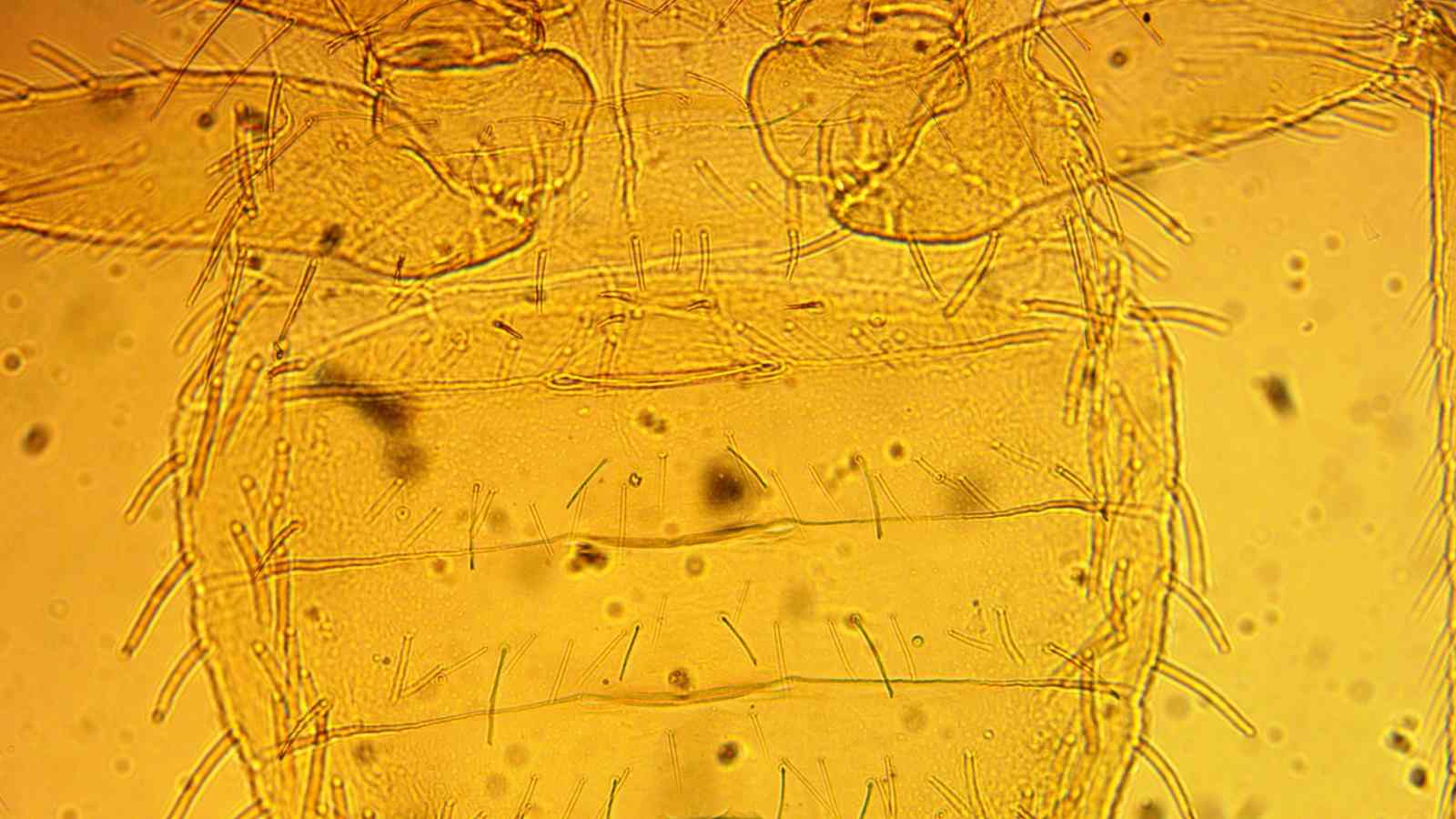
The head of an adult bed bug is equipped with a pair of prominent, segmented antennae. Beneath these antennae, you can spot its piercing-sucking mouthparts, which it uses to feed on the blood of its host. When not in use, these mouthparts are folded under the head.
Moving down the body, you’ll notice the thorax, which bears six legs. The legs are relatively short and adapted for crawling rather than jumping. Bed bugs lack wings, so they are unable to fly.
Finally, the abdomen of an adult bed bug is slightly rounded and elongated, and it can expand significantly after a blood meal. If the bed bug has recently fed, the abdomen will appear swollen and redder due to the ingested blood.
Bed Bug Images Before and After Feeding
The bed bug images below depict a bed bug as it gradually fills with blood during a blood meal. It’s quite intriguing because the final images do not exactly match our preconceived notions of what bed bugs look like.
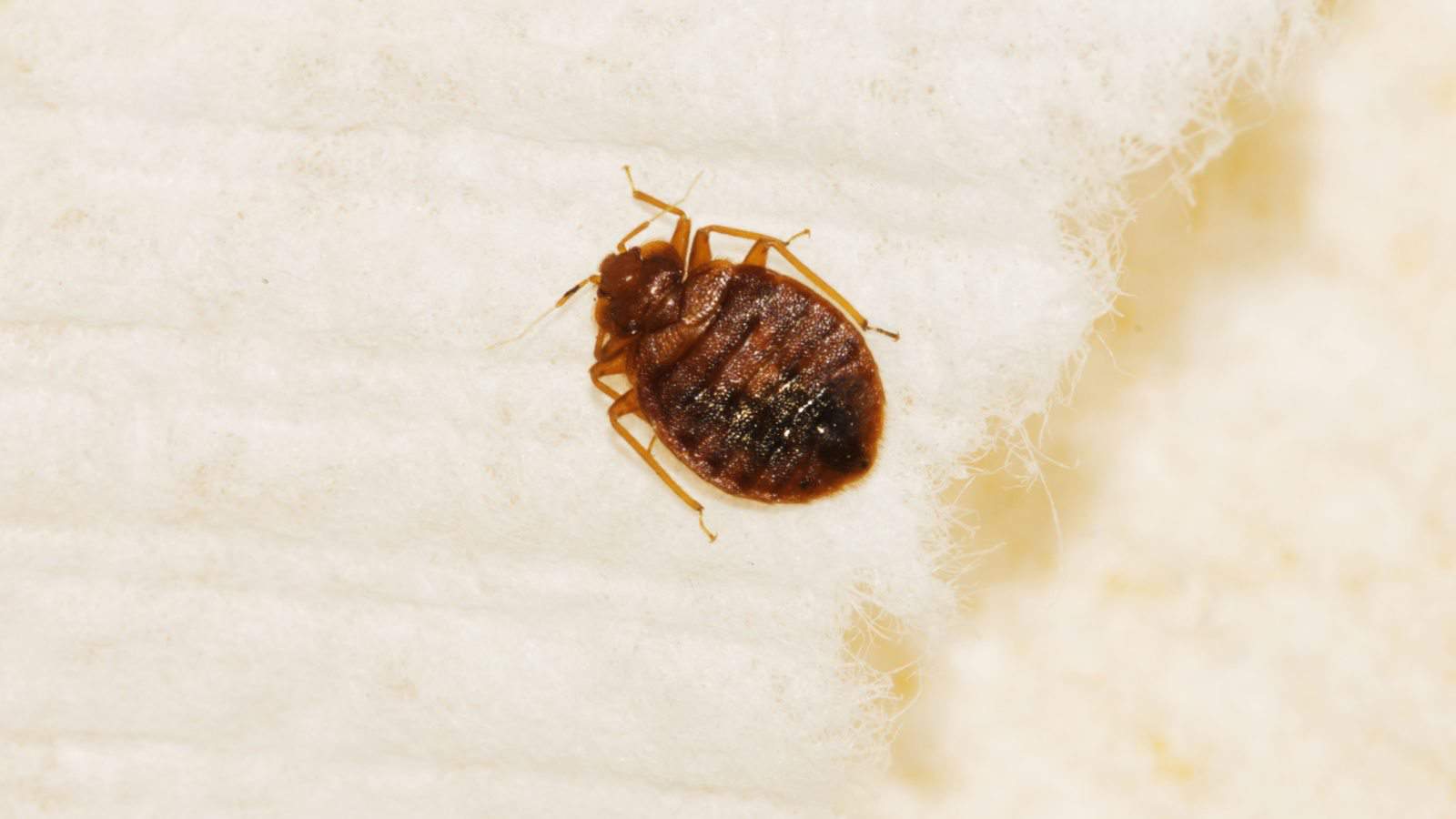
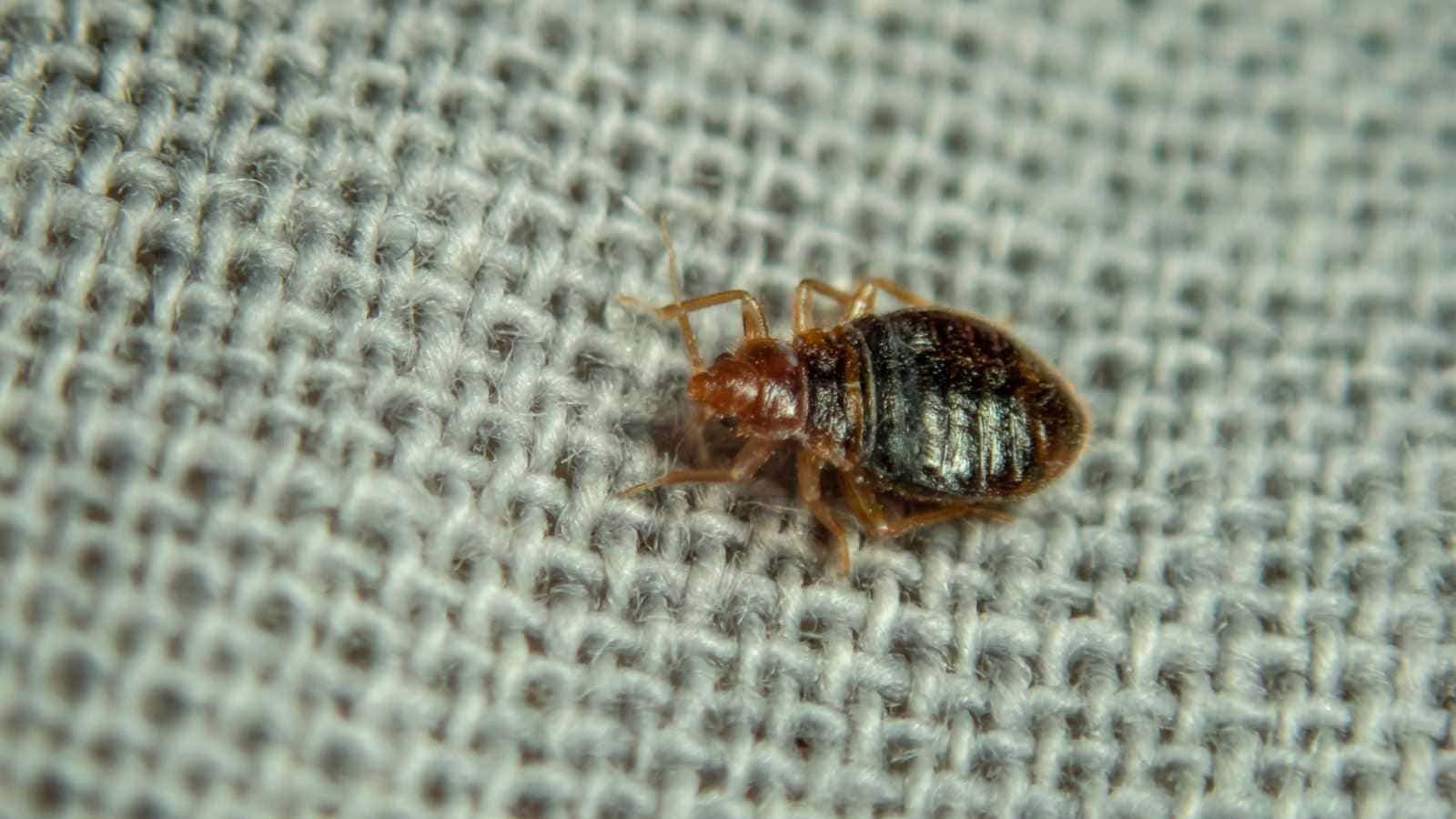
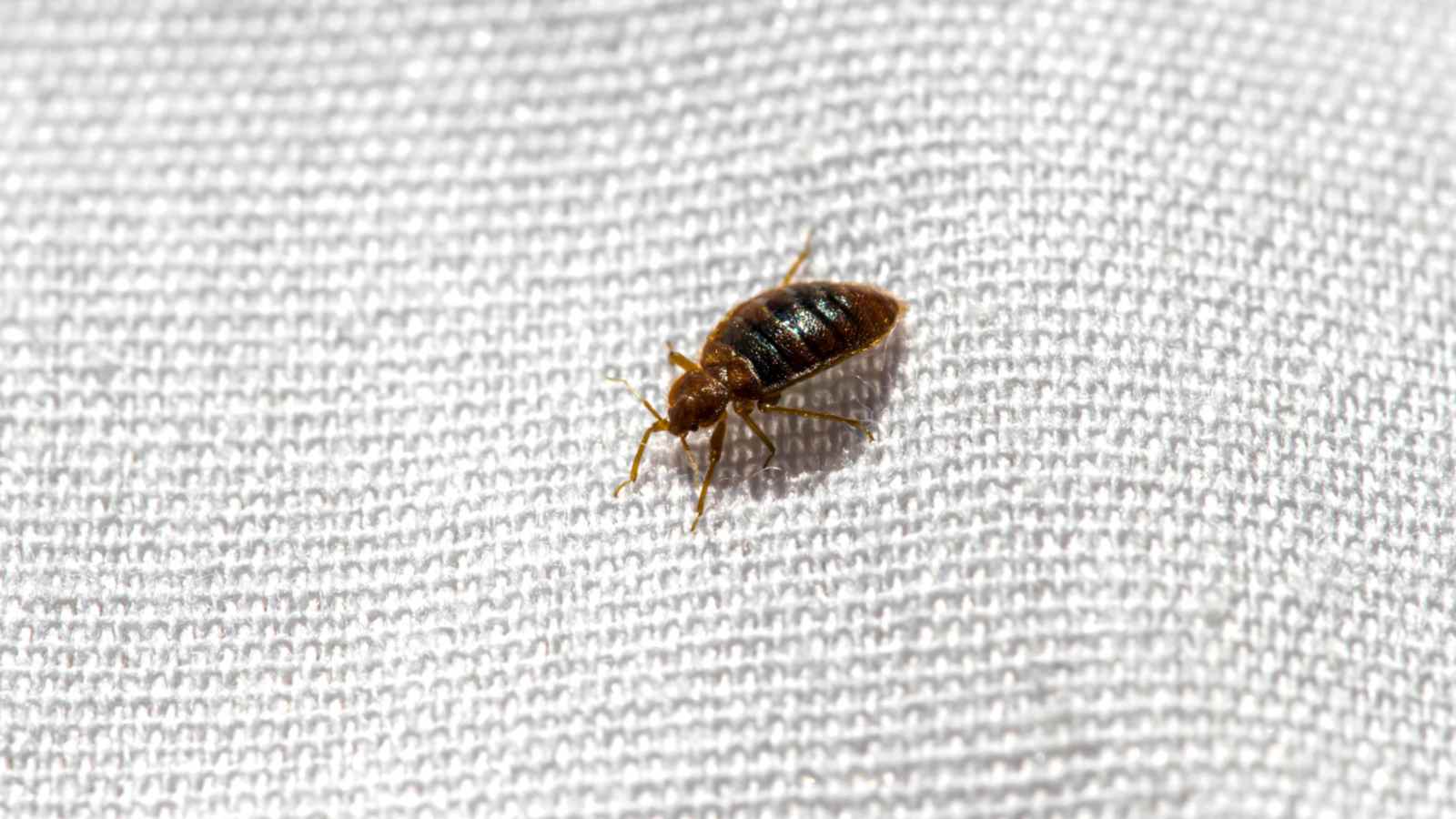
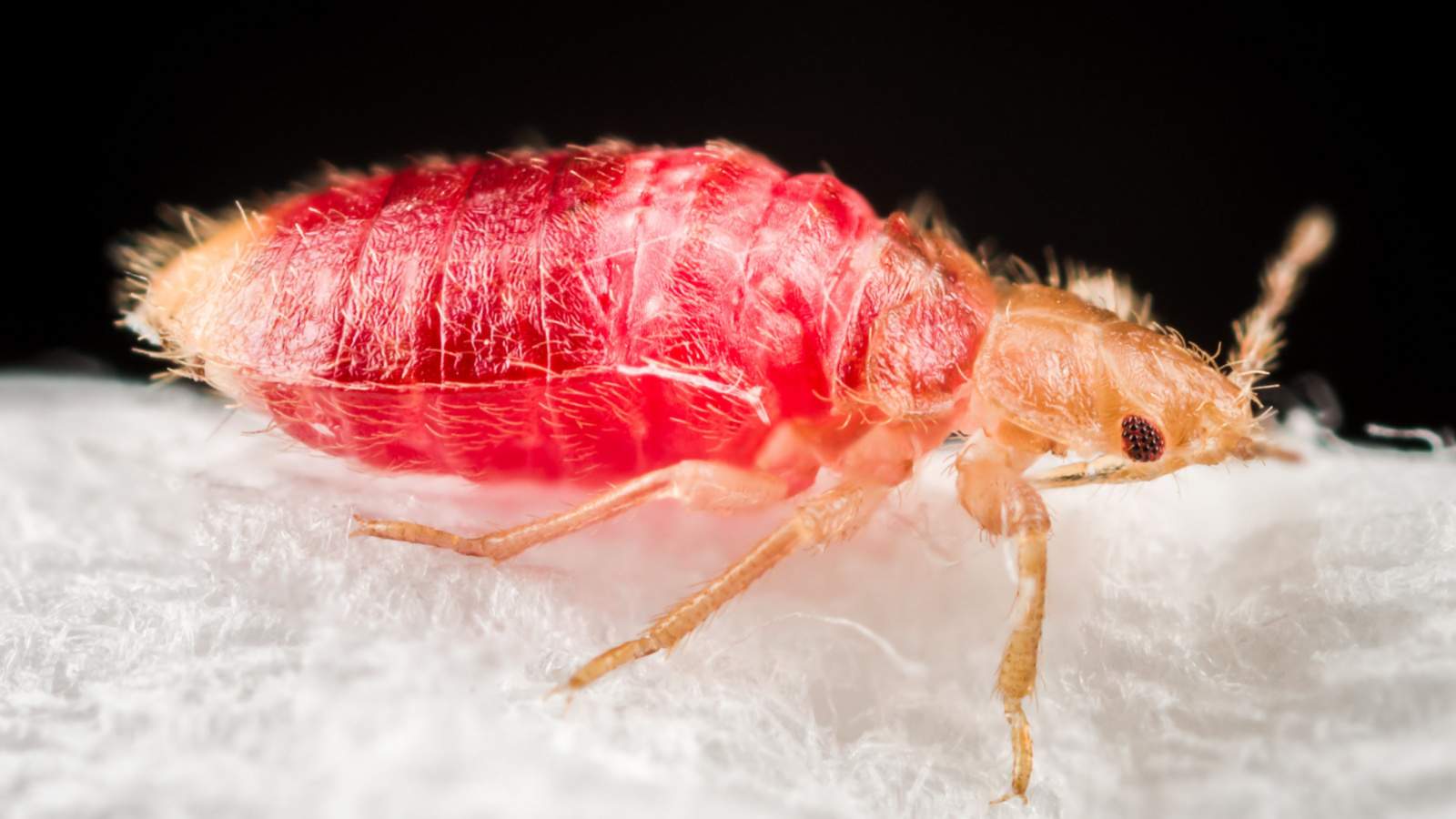
Their flat body becomes more rounded as they consume up to seven times their own weight in food.
Bed Bug Pictures Through Different Development Stages
The size and appearance of bed bugs drastically change over the course of five stages of development, from almost translucent to finally becoming a dark brown adult bed bug.
Bed bugs need to eat in order to grow and move through each of the five stages. They cannot develop into adult bed bug and begin to reproduce without a blood meal.
Female bed bugs can lay hundreds of eggs, each about the size of a speck of dust, over a lifetime.
Because of this, preventing them from feeding is essential for a successful treatment. This can be done with climbup interceptors and traps as well as certified approved bedding encasements.
1. Bed Bug Egg Images
Before a bed bug hatches from its egg, it appears as a tiny, oval-shaped, pearly-white structure.
These eggs are about the size of a pinhead and are often clustered in groups, typically found in cracks and crevices near their feeding sources. For more information about
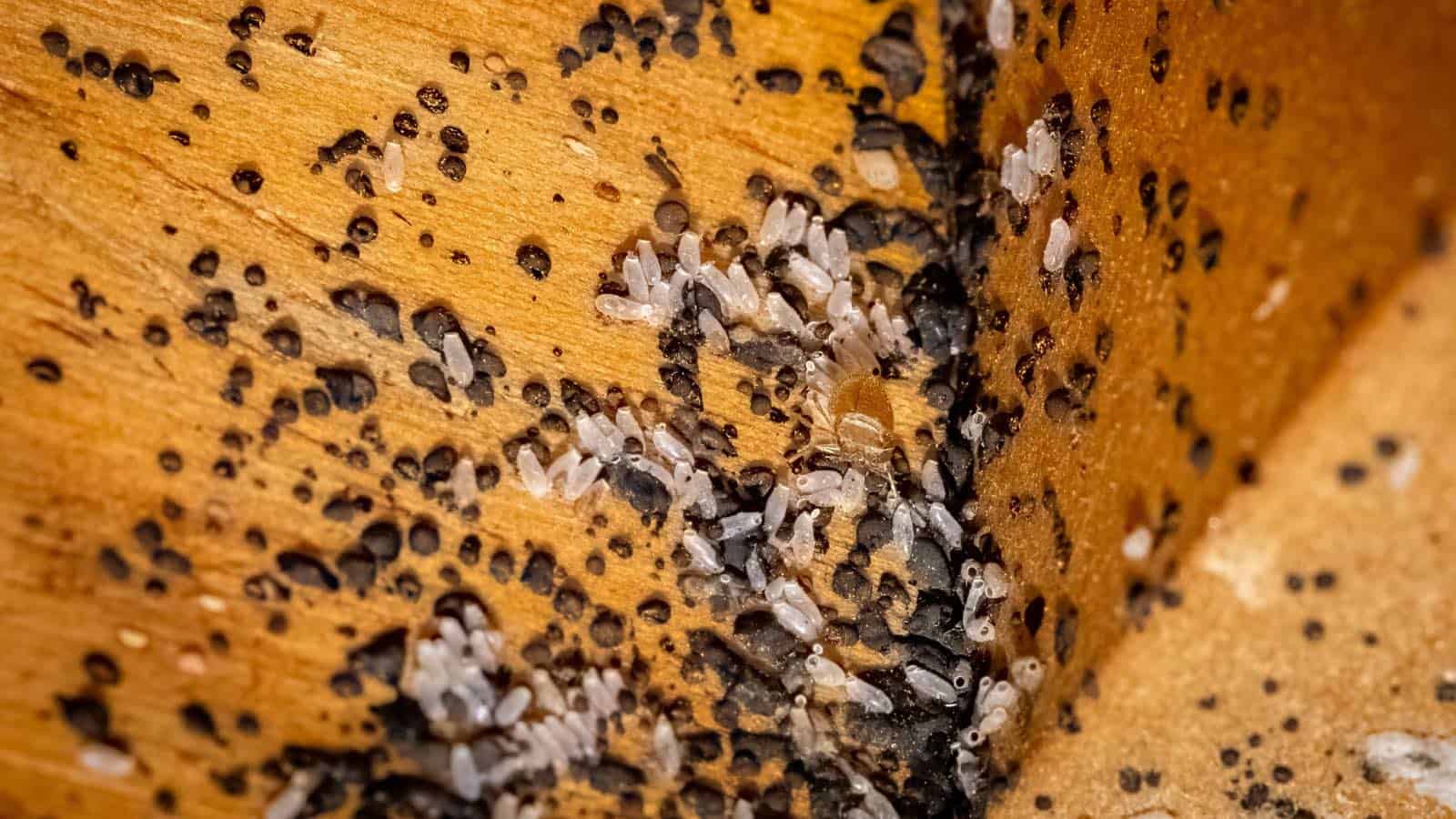
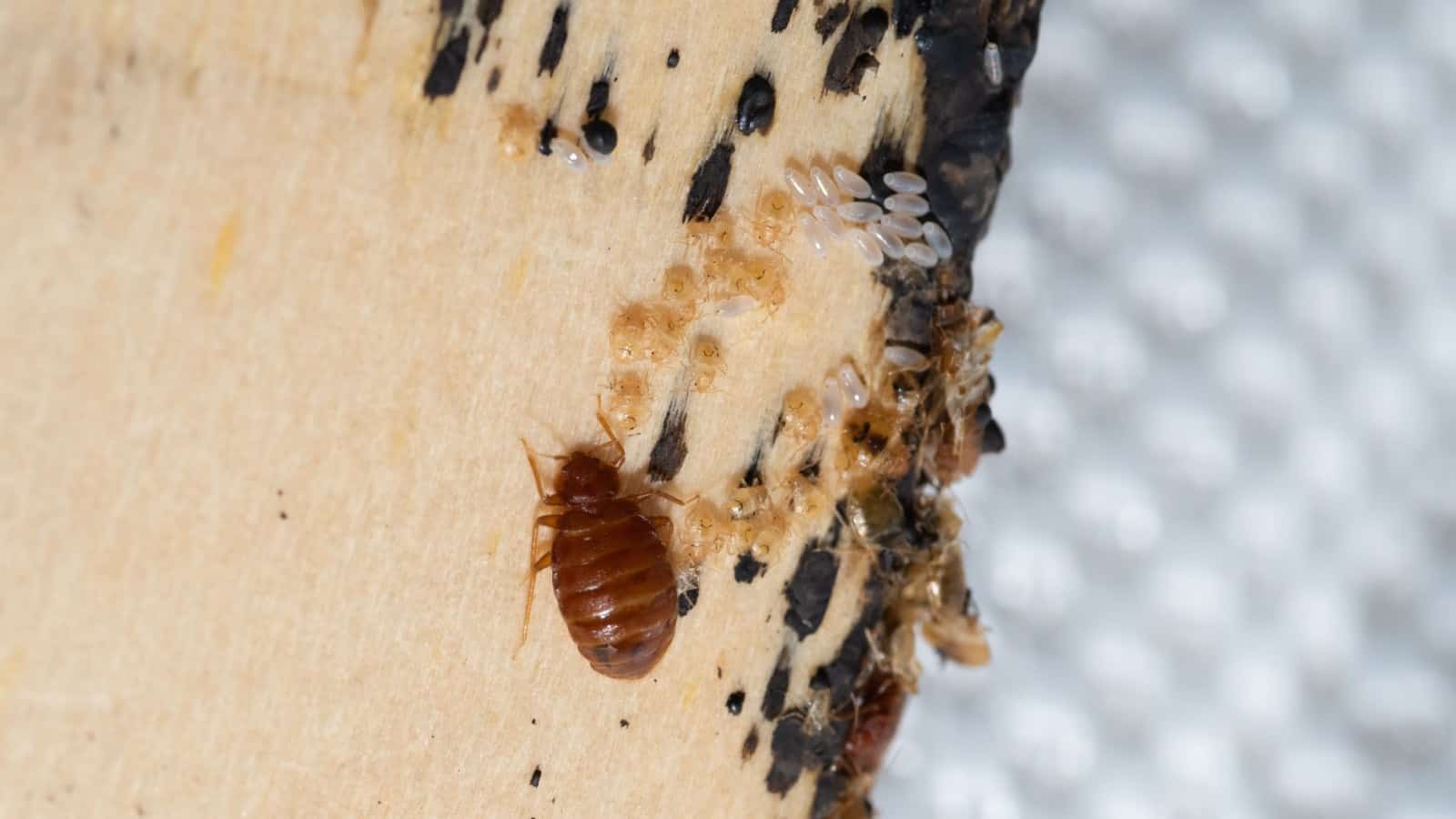
2. First Instar Nymph Image
After hatching, a first instar nymph is extremely small, about 1-1.5 millimeters in length.
It appears translucent and nearly colorless, with a slightly tan or beige hue.
At this stage, bed bugs have only six legs and lack the distinctive reddish-brown coloration of adults.
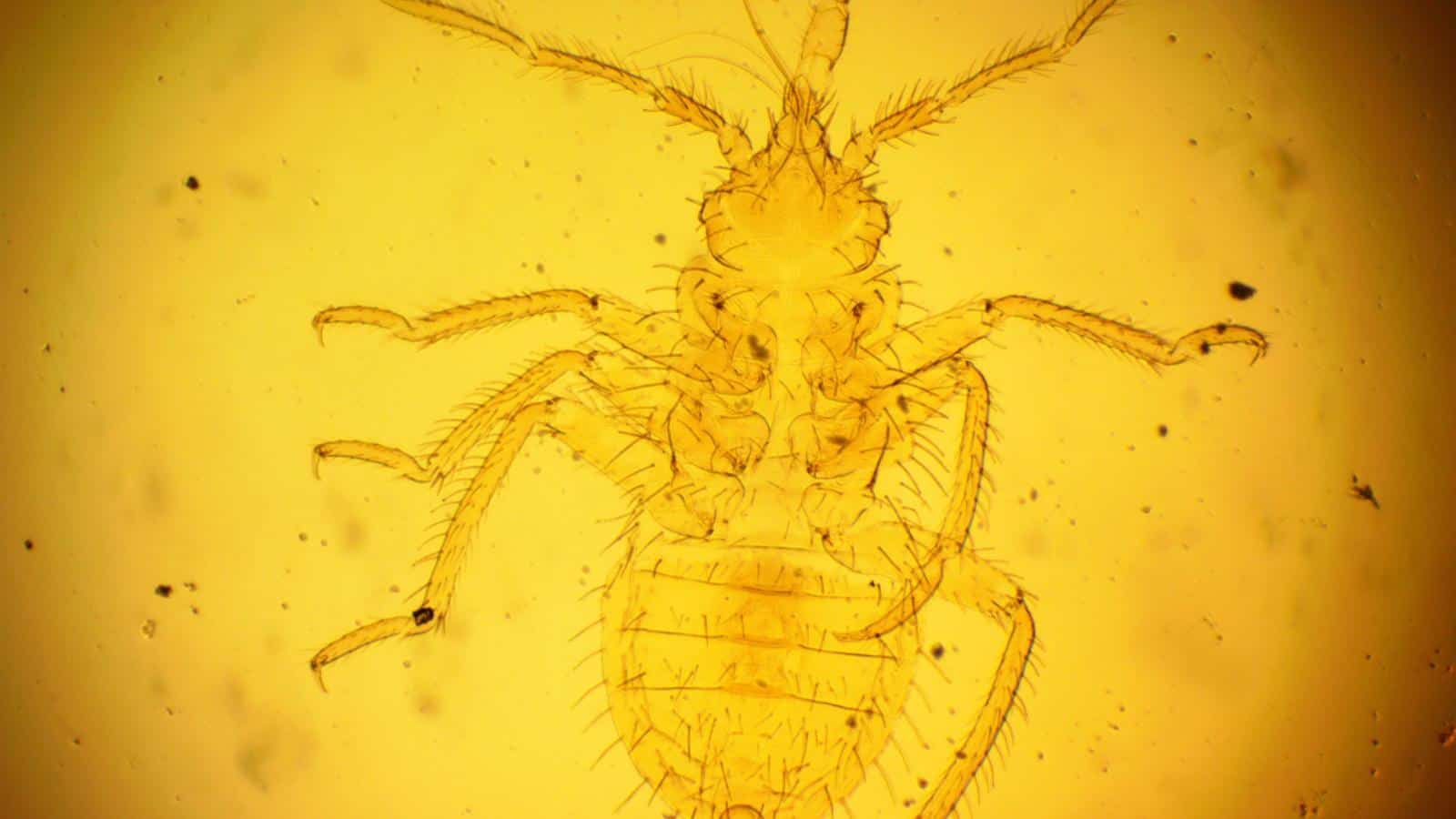
3. Second Instar Nymph Image
As the nymph molts into its second stage, it grows a bit larger, measuring around 2-2.5 millimeters.
It still maintains a translucent appearance but may show subtle darkening, especially in its abdomen.
The nymph’s body begins to take on a more pronounced oval shape.
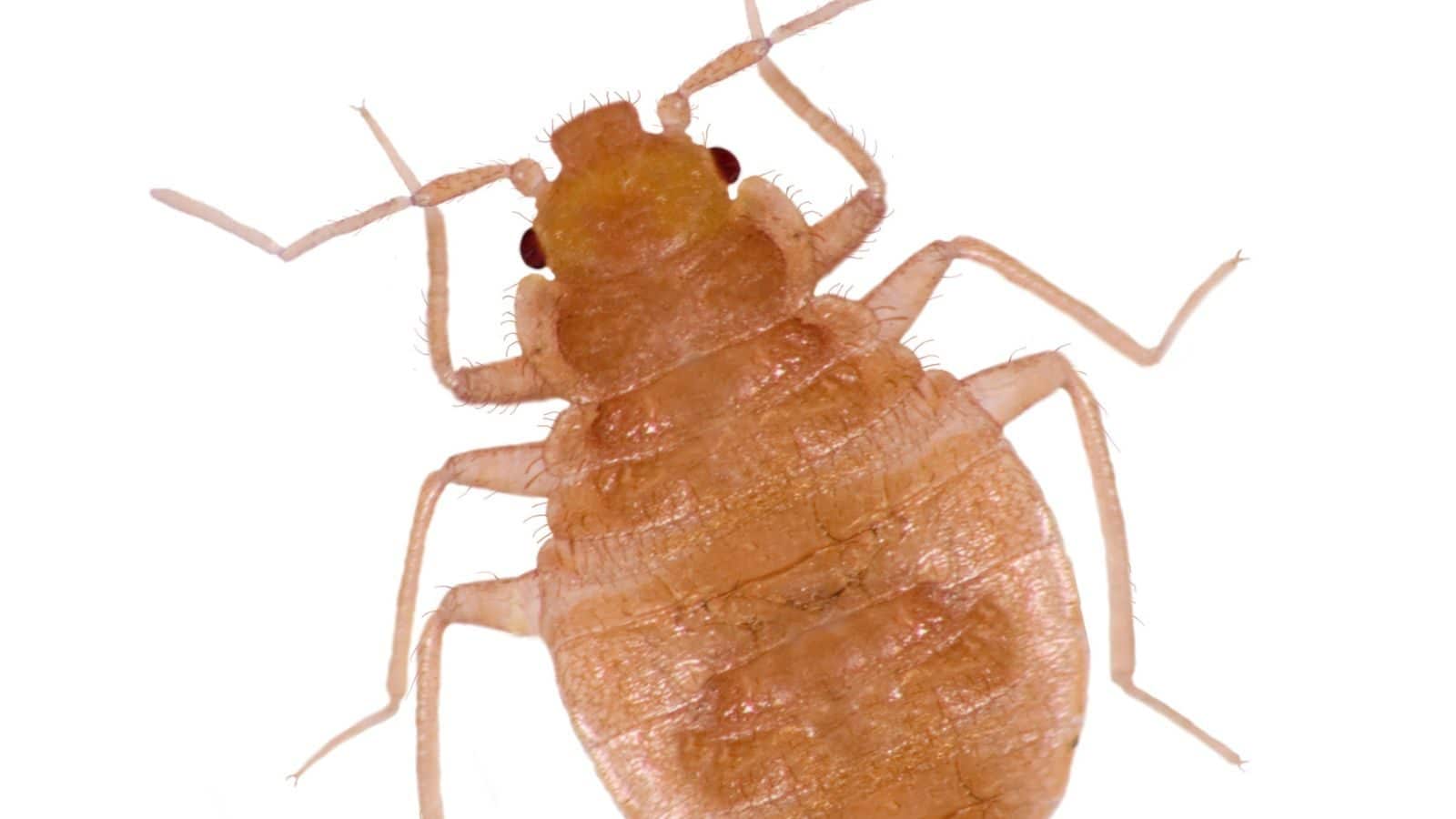
4. Third Instar Nymph Image
By the third instar stage, the nymph is about 2.5-3.5 millimeters in length.
Its body starts to develop a slightly darker reddish-brown color, and the abdomen becomes more elongated.
The nymph now has more distinct segmentation and features, including visible antennae and mouthparts.

5. Fourth Instar Nymph Image
In this stage, the nymph measures approximately 4-4.5 millimeters.
Its coloration deepens, and it begins to resemble a smaller version of an adult bed bug.
All the key features, such as the six legs, antennae, and segmented body, are more pronounced.

6. Adult Bed Bug Image Before a Blood Meal
The adult bed bug, when unfed, is about 4-5 millimeters long.
It exhibits a reddish-brown to mahogany color, which can vary depending on its age and recent feeding history.
The body is oval and flattened, and it appears relatively sleek and streamlined.
The abdomen is neither swollen nor noticeably elongated.
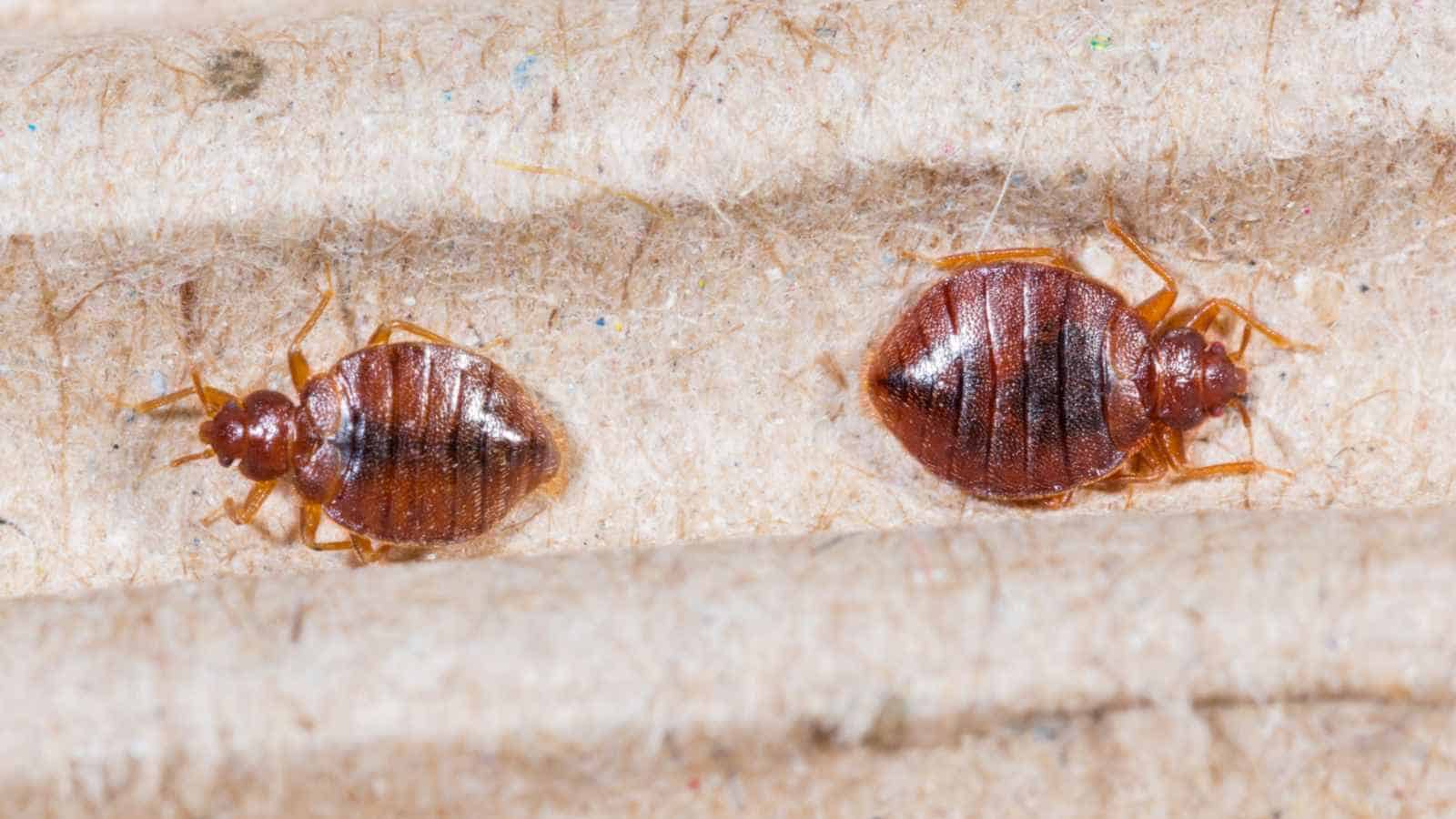
7. Adult Bed Bug Image After a Blood Meal
After feeding on blood, the adult bed bug undergoes a significant change in appearance.
Its abdomen becomes visibly swollen and elongated, taking on a redder and more engorged appearance.
The bed bug’s overall body size may increase by about 50%.
This post-feeding appearance is a notable indicator of a bed bug that has recently fed on a host.
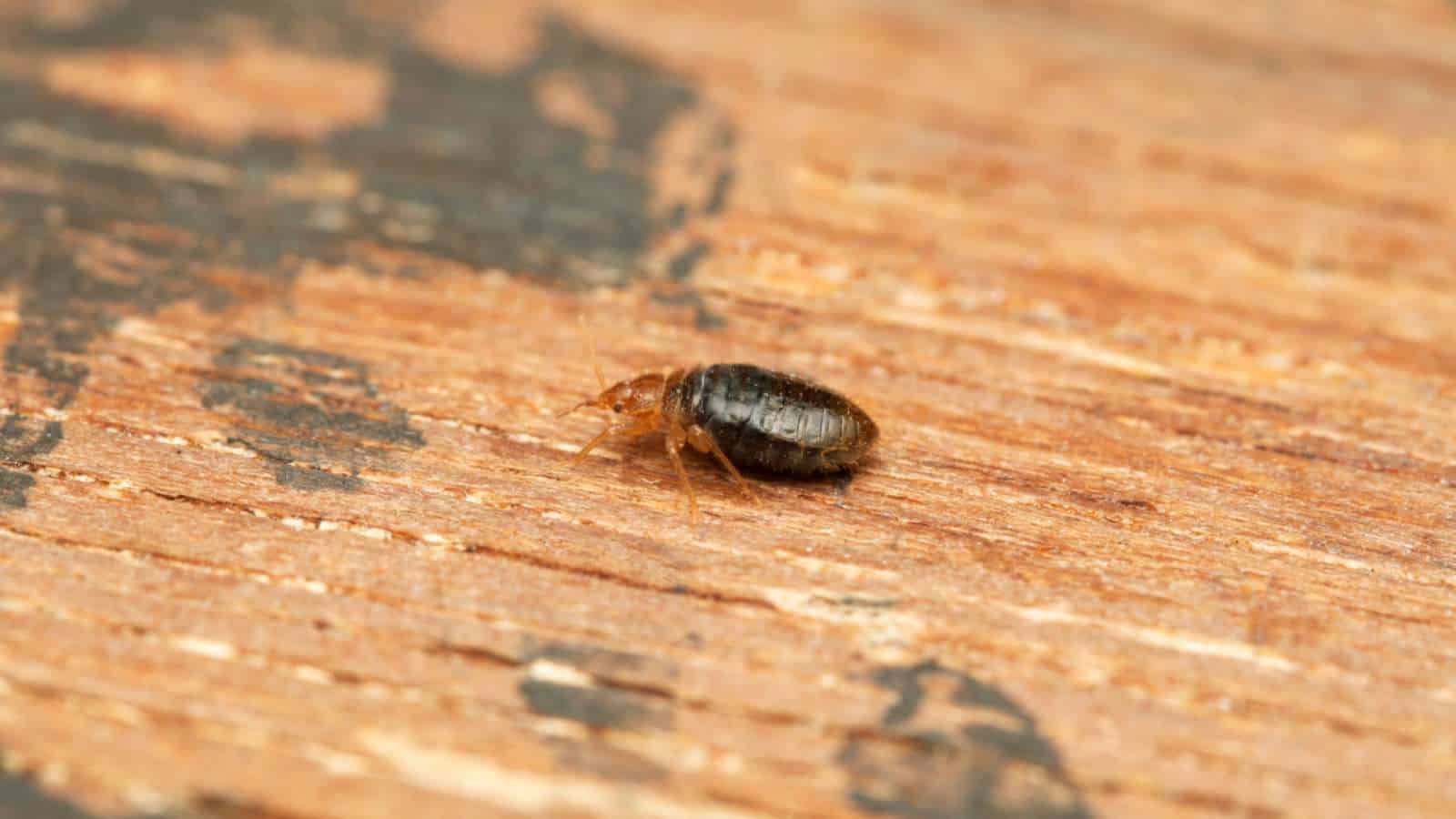
Bed Bug Pictures Around the House
Identifying what bed bugs look like in different areas and settings around the house is key to resolving an infestation. Let’s look at the 15 most common locations, along with images, and descriptions:
1. Mattress Seams
When bed bugs hide in the seams of a mattress, you might see them as tiny, reddish-brown insects.
They tend to cluster near the seams, where they can access their host for a blood meal. In this location, they appear relatively flat and oval, blending into the fabric’s creases.
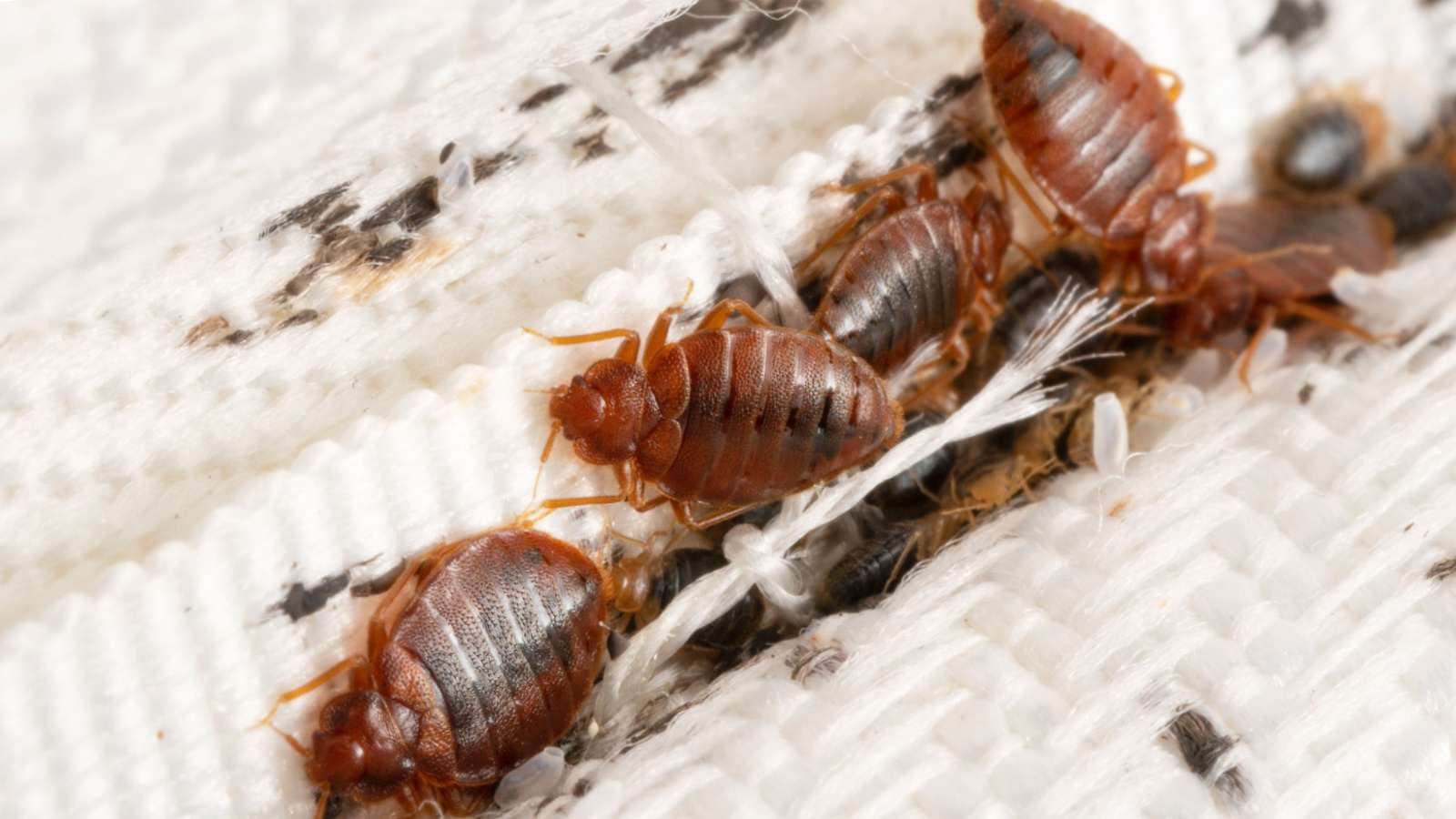
2. Box Spring
Bed bugs often find harborage in the folds and crevices of a box spring. Here, they may appear slightly larger than when on a mattress, but still with their distinctive reddish-brown coloring.
Their flattened bodies help them squeeze into tight spaces within the box spring structure.
3. Cracks in Wooden Furniture
When bed bugs hide in the cracks and joints of wooden furniture, they are adept at camouflaging.
In such locations, they can resemble small, brown specks or dark dots. Their segmented bodies may be visible if you look closely.

4. Baseboards and Wall Trim
Bed bugs often seek shelter behind baseboards and wall trim. Here, they can appear as tiny, flat insects with a reddish-brown hue.
Their narrow bodies allow them to fit snugly in the crevices between the wall and baseboard.
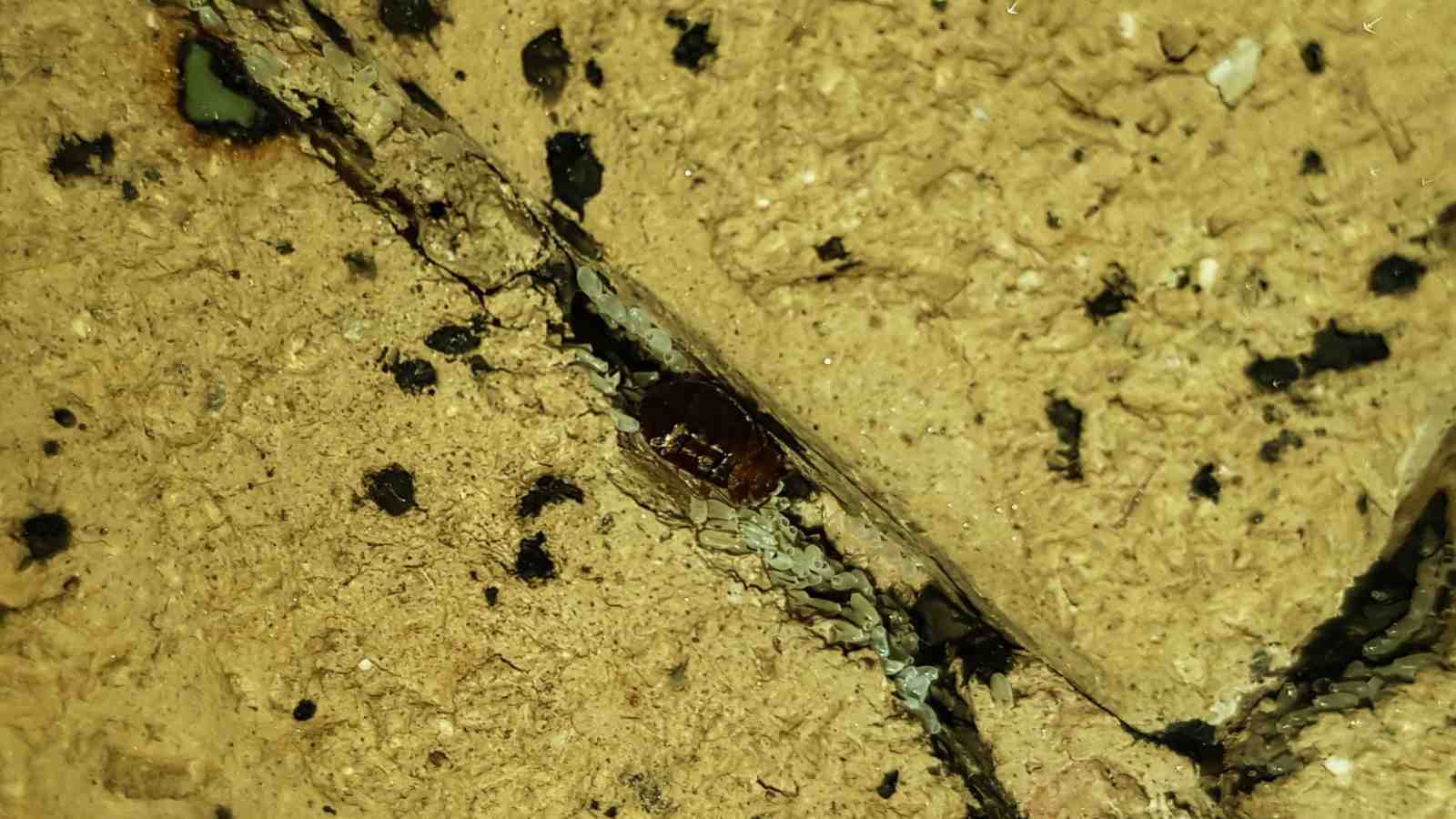
5. Electrical Outlets
In electrical outlets and switch plates, bed bugs can be difficult to spot. They may look like small, dark spots or irregularities within the outlet.
Bed bugs are skilled at finding hiding spots in these tight spaces.

6. Behind Wallpaper
Behind wallpaper, bed bugs can be challenging to detect. They might appear as faint, reddish-brown stains or tiny, crawling insects.
Their presence may cause the wallpaper to peel or bubble in some cases.
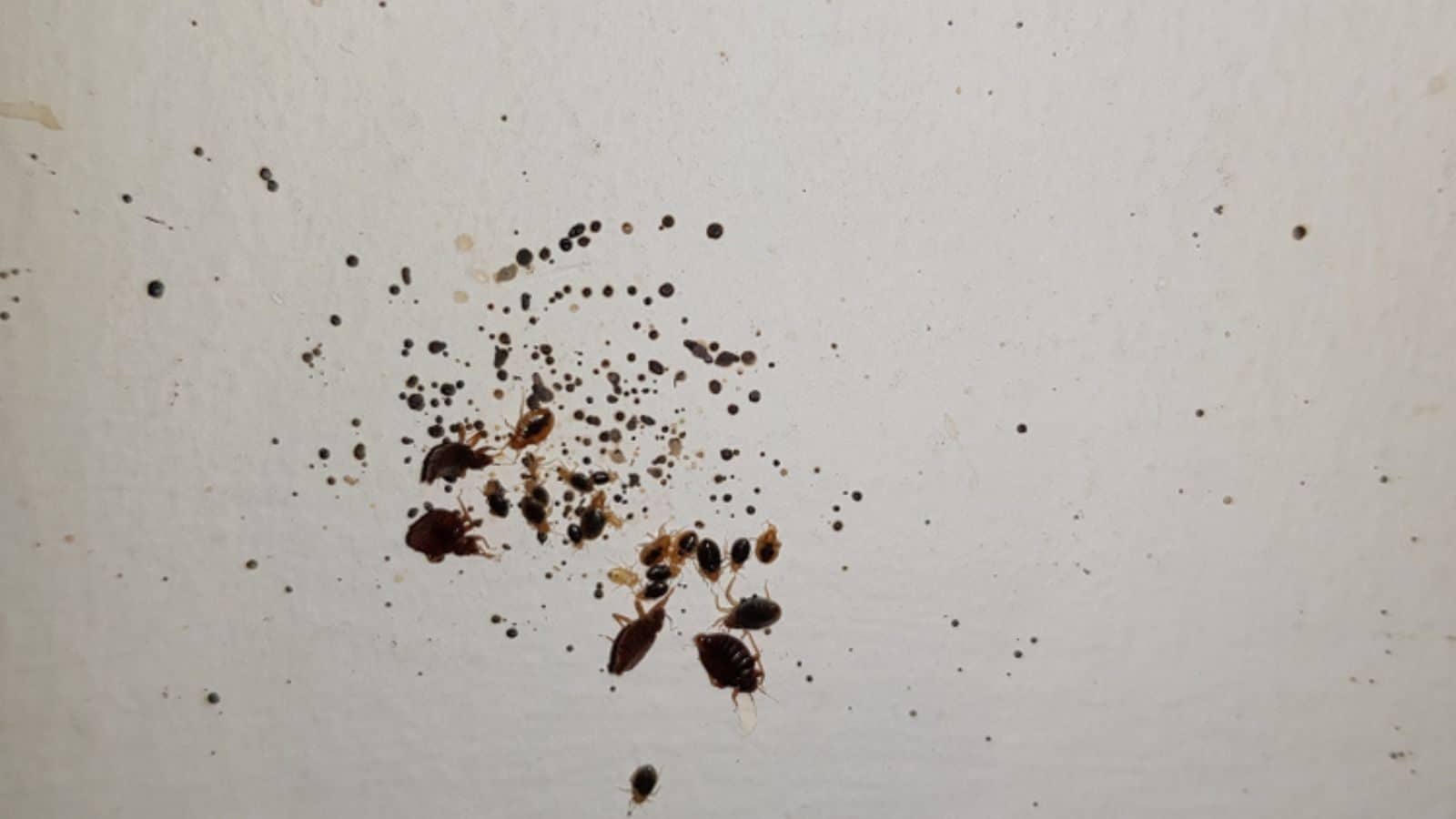
7. Luggage and Personal Belongings
When bed bugs infest luggage or personal items, they often cling to fabrics. They can look like tiny, reddish-brown specks on clothing, linens, or inside luggage compartments.
Bed bugs in these locations may leave behind dark fecal stains.

8. Wall Void
In wall voids, bed bugs might be concealed within insulation or behind the walls themselves.
They may not be visible in this location, but you may notice reddish-brown fecal spots or shed exoskeletons as indicators of their presence.
Sometimes, you may spot a bed bug crawling along the edge of a wall or ceiling.
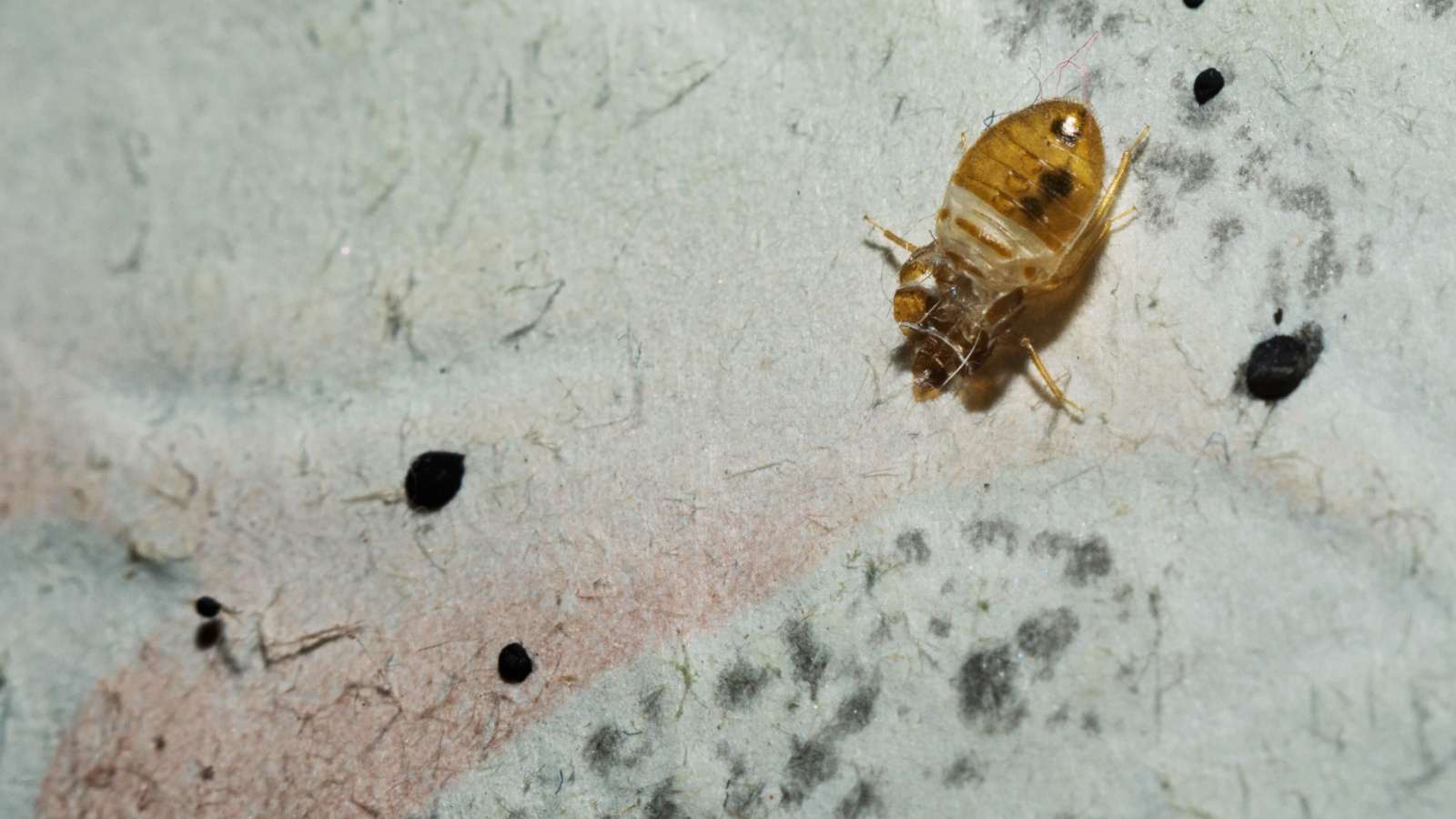
9. Picture Frames
Bed bugs can sometimes find their way behind picture frames hanging on walls. They may appear as tiny, reddish-brown specks along the frame’s edges or inside the frame.
Their presence may also cause the frame to detach slightly from the wall.
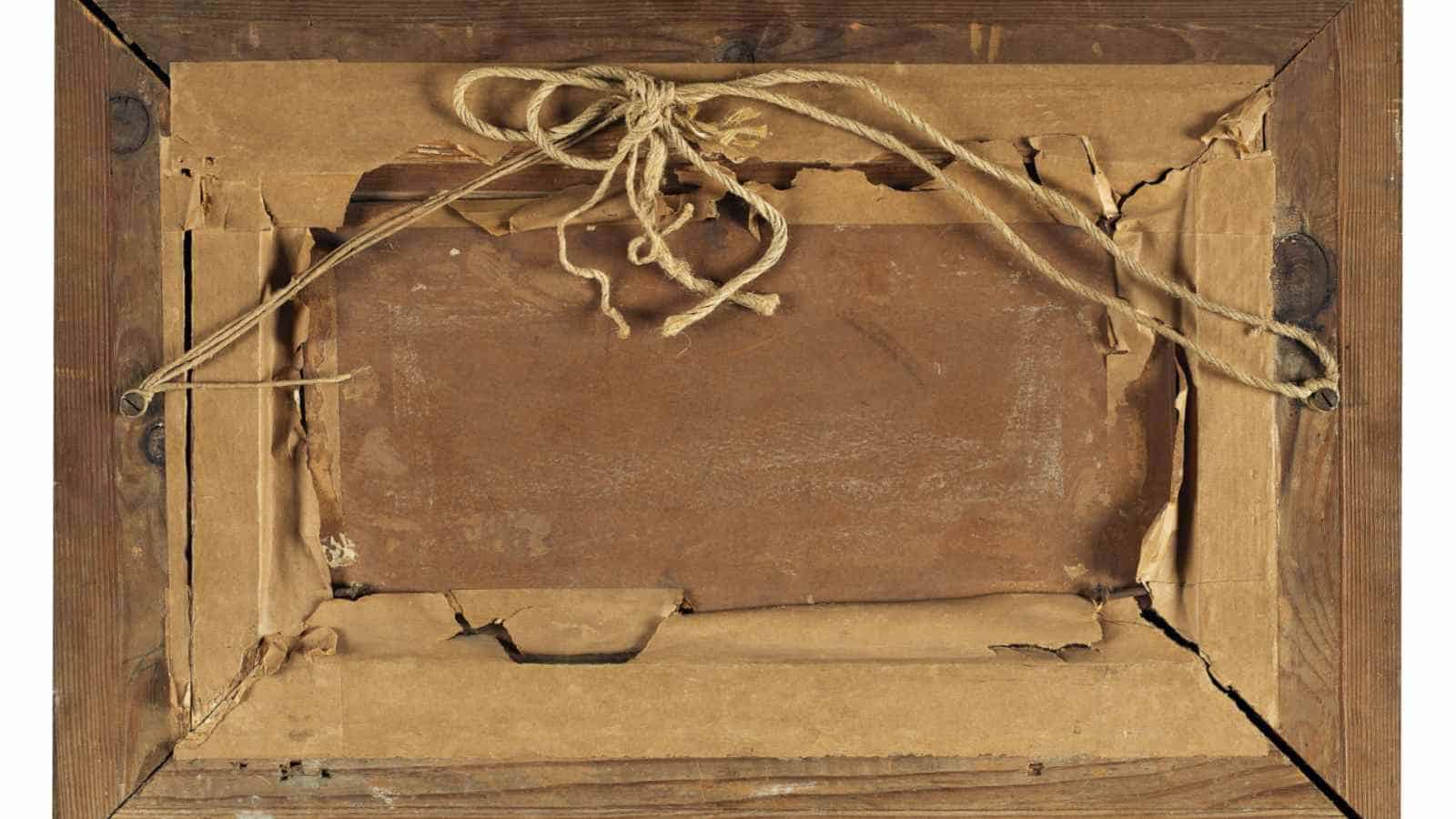
10. Books and Bookshelves
In bookshelves or stacks of books, bed bugs can hide between pages or along the spines. They might look like small, dark smudges or tiny insects crawling amidst the pages.
Be cautious when handling infested books to prevent their spread.

11. Curtains and Drapes
Bed bugs may take refuge in the folds and pleats of curtains or drapes. They can resemble small, reddish-brown dots on the fabric.
Pay attention to any irregularities in the fabric or areas with tiny dark stains.

12. Wall Clocks
Bed bugs can hide behind wall clocks, particularly if they have a gap between the clock and the wall. They may look like dark spots or specks on the wall near the clock’s location.
Examine the area around wall-mounted objects for signs of infestation.
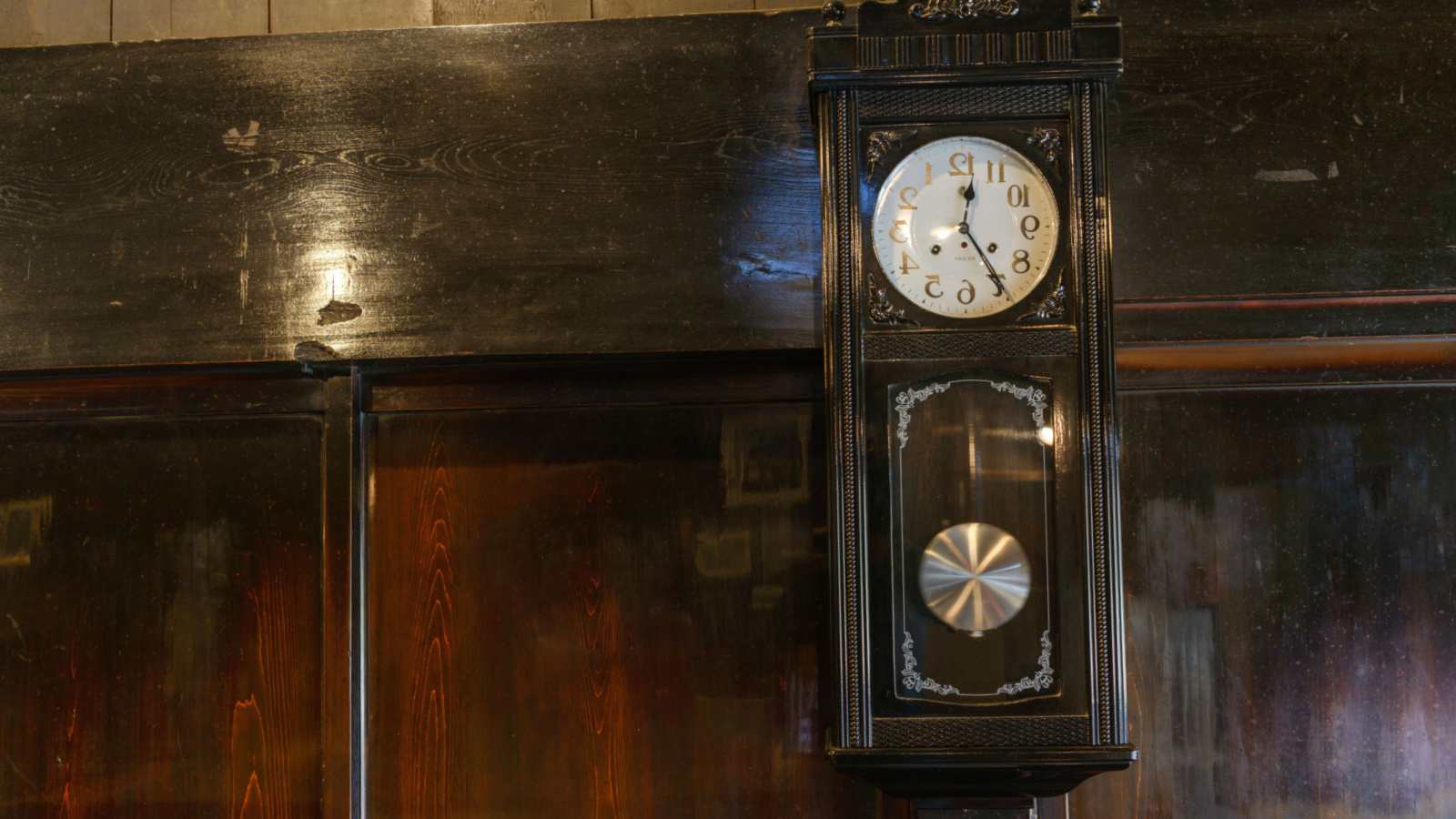
13. Ceiling and Light Fixtures
While not a common hiding place, bed bugs may occasionally be found on ceilings or within light fixtures. They can appear as small, brownish spots on the ceiling or inside the fixture.
Check for any unusual spots or stains on the ceiling and around light fixtures.

14. Upholstered Furniture
In upholstered furniture such as sofas and chairs, bed bugs may be found in seams, folds, and crevices. They can look like flat, reddish-brown insects nestled within the fabric.
Infested furniture may also have dark fecal stains or shed exoskeletons.
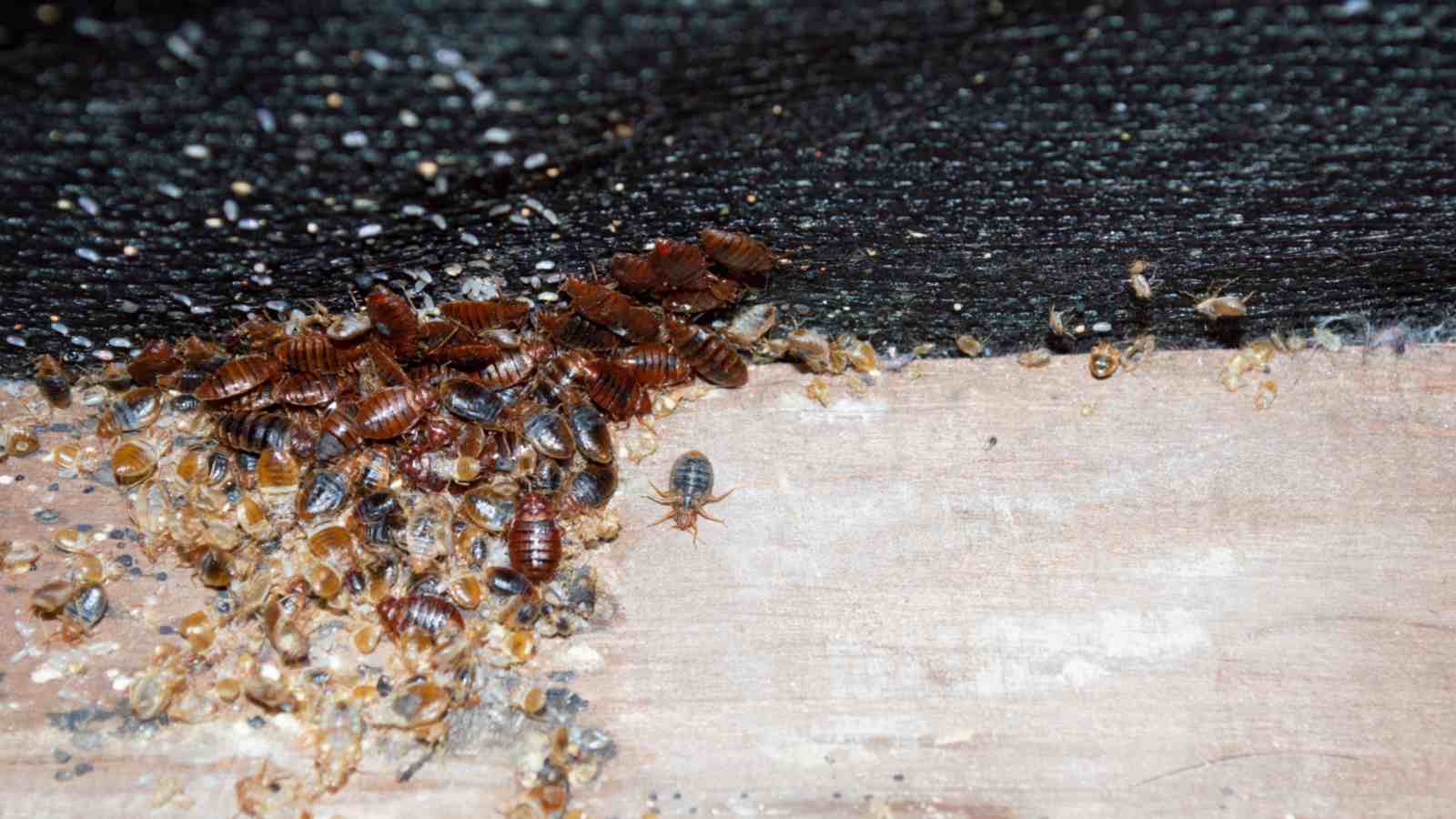
15. Pet Beds and Bedding
Bed bugs can hide in pet beds or in the bedding of dogs or cats. They may appear as tiny, dark spots on the pet’s bedding material.
Be sure to inspect pet sleeping areas if you suspect a bed bug infestation.

Bed Bug Bites Pictures
Identifying bed bug bites is key to figuring out if your living space has been infested by these pesky insects.
Let’s look at different images of bed bug bites to identify them better:
1. Cluster of Bed Bug Bites
A cluster of bed bug bites typically appears as a group of small, red or pinkish bumps on the skin.
The bites are closely grouped together in a localized area, often resembling a line or cluster of dots. They may be itchy and surrounded by slightly inflamed skin.
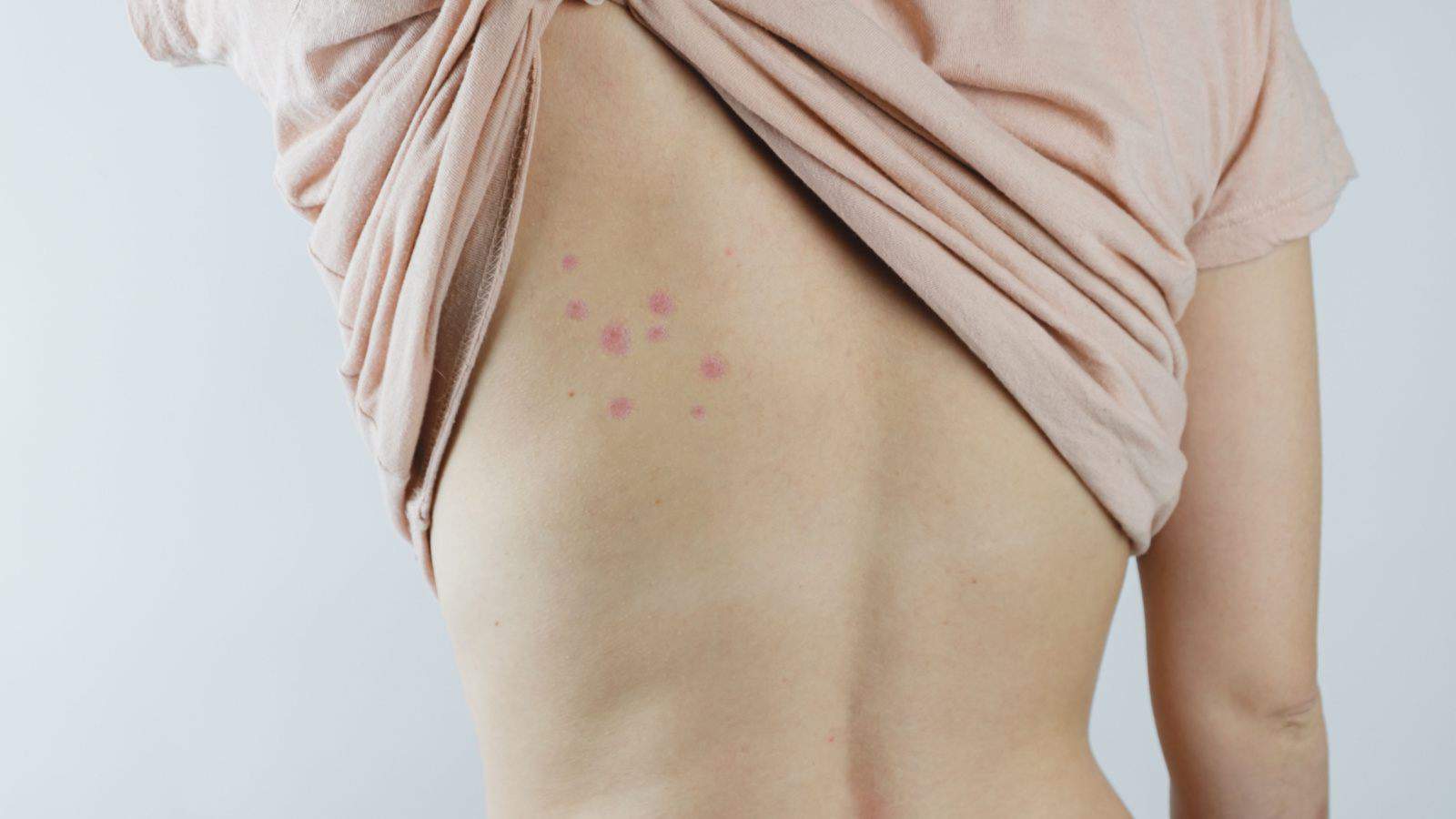
2. Rash from Bed Bug Bites
A bed bug bite rash presents as a larger, reddened area on the skin.
It may consist of multiple individual bites that have merged together, creating a patchy appearance. The rash can be quite itchy and may cause discomfort.
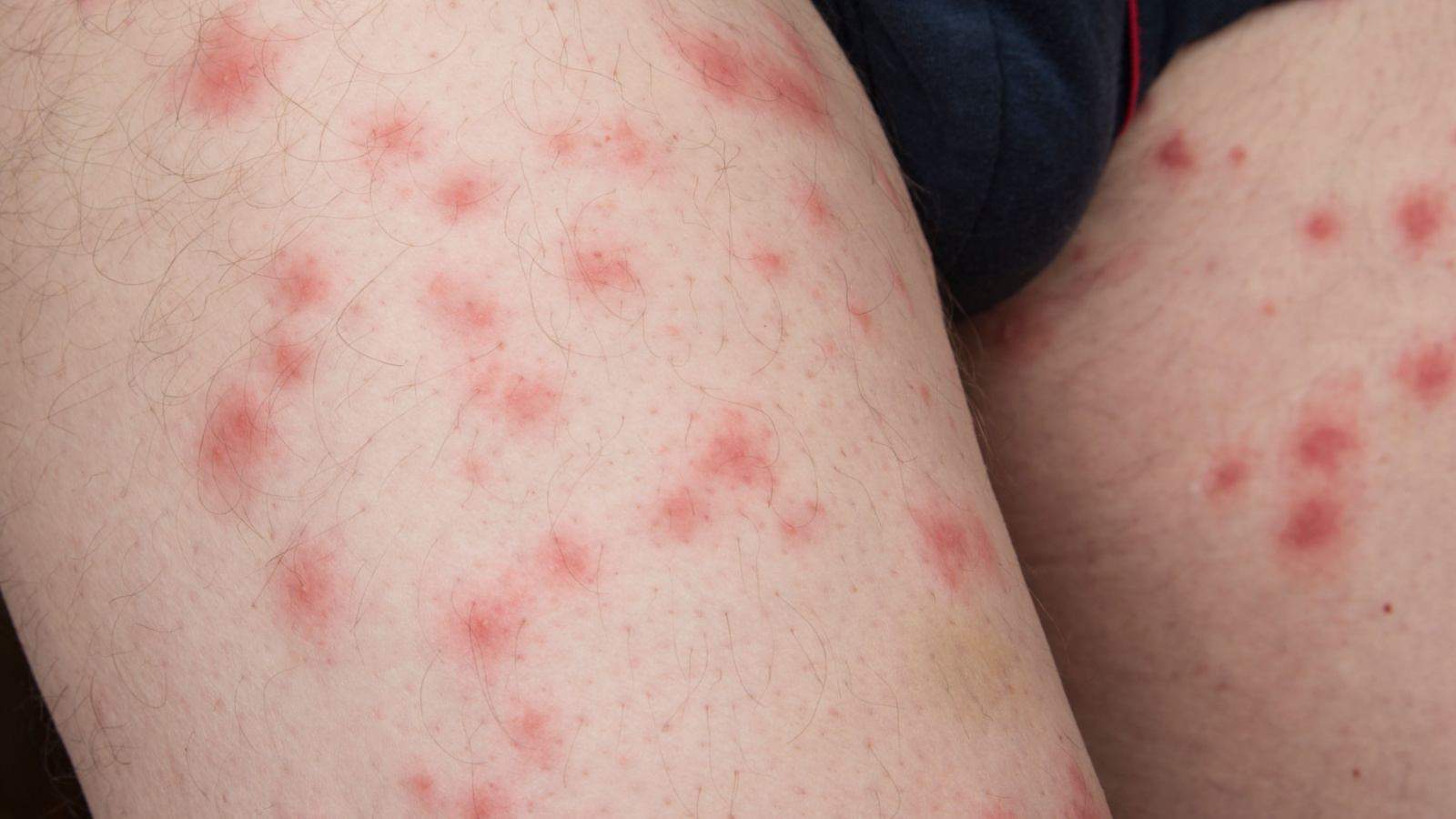
3. Bed Bug Bite Scarring
Over time, bed bug bites can leave behind scars, especially if they have been scratched excessively.
The scars often appear as slightly raised, discolored areas on the skin, ranging from pink to brown. These scars may persist long after the initial bites have healed.
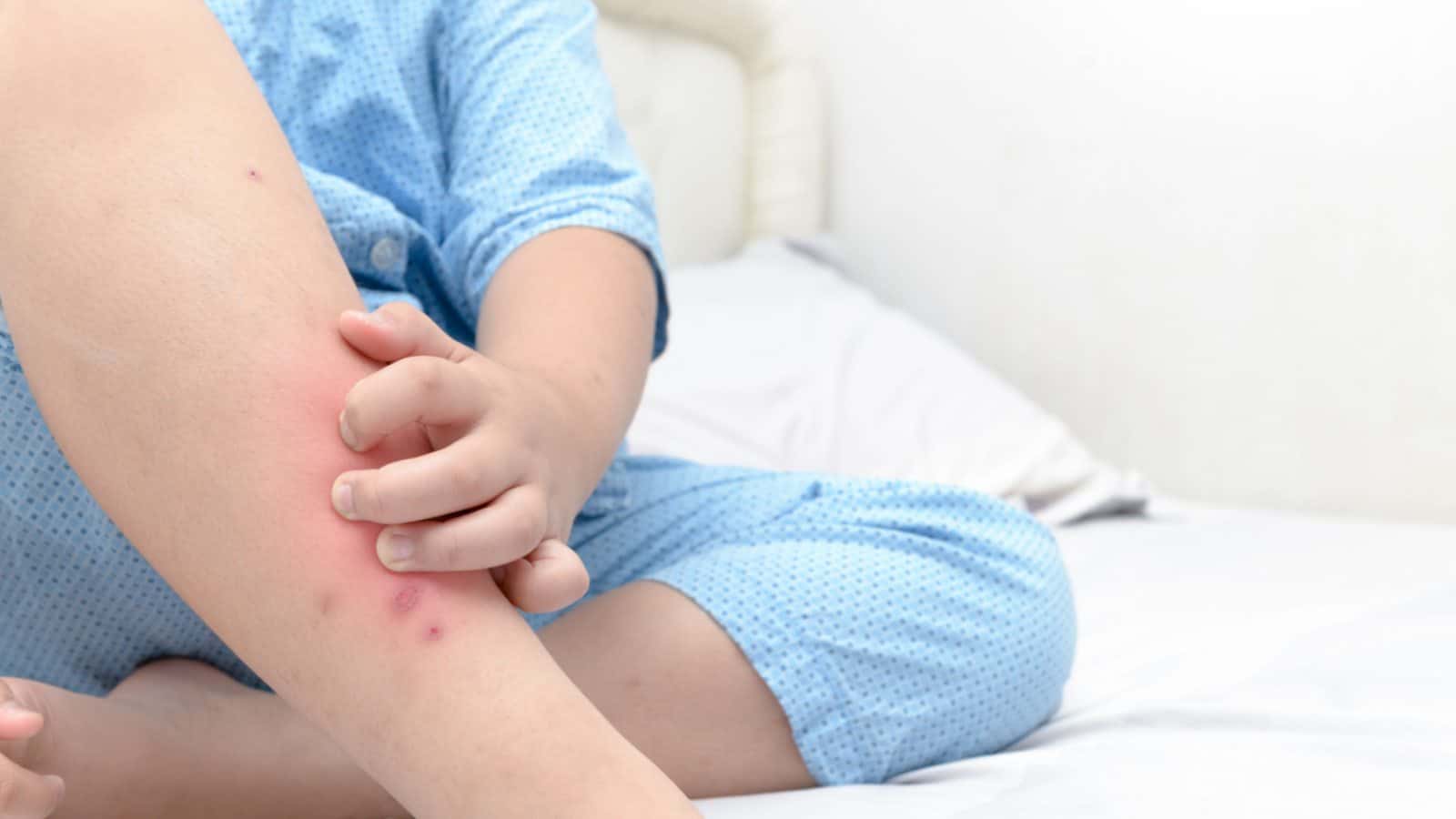
4. Aggravated Bed Bug Bites from Scratching
Bed bug bites that have been scratched vigorously can become more pronounced and inflamed.
They may appear as red, swollen, and possibly open sores due to excessive scratching. These aggravated bites can be more painful and prone to infection.
A bedbug bite could become infected if you scratch it until the skin breaks. Some people are allergic to the bites. Bites can cause hives, blisters, or intense itching in them. Consult your doctor if you experience a severe reaction or severe skin irritation.
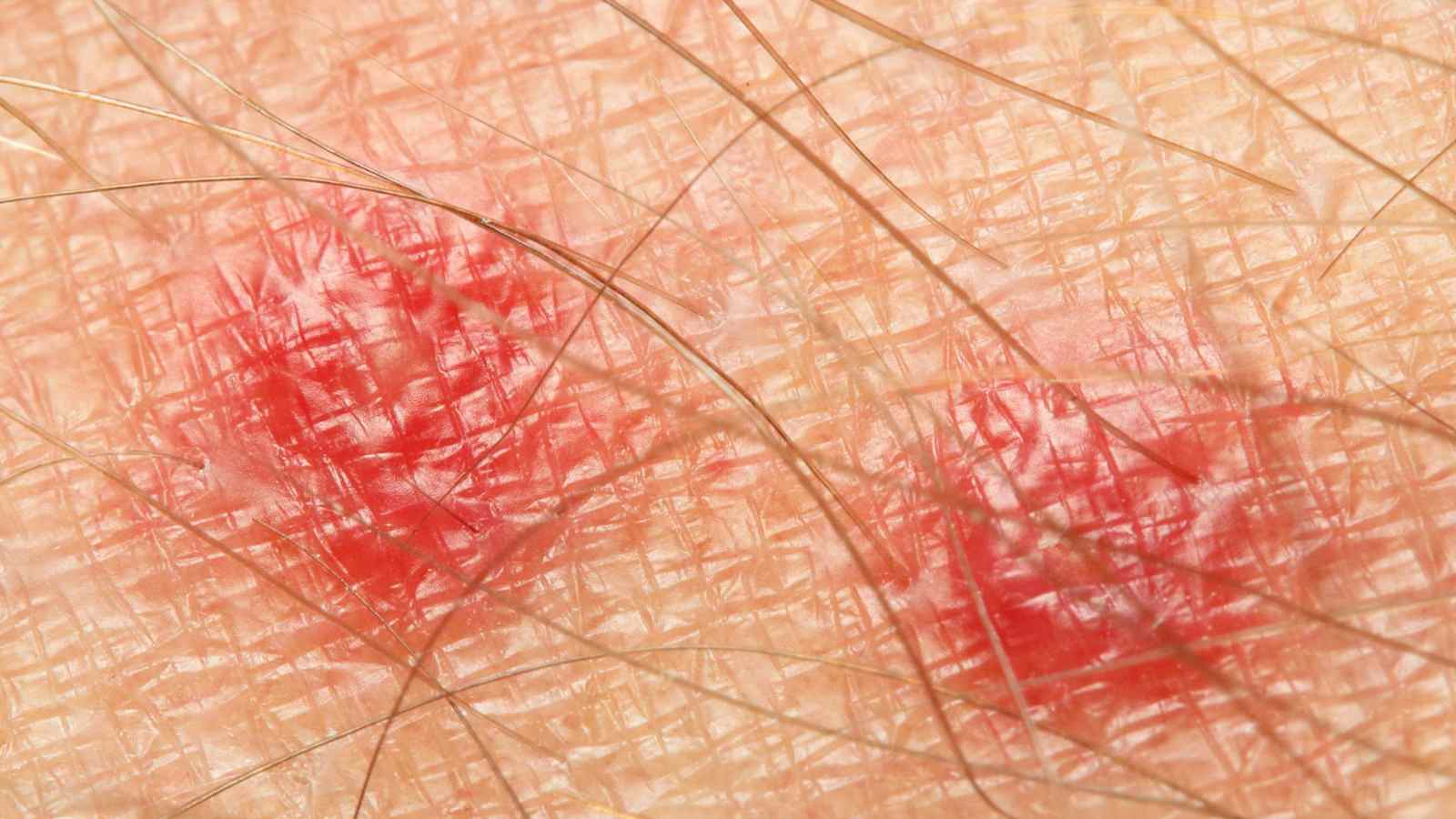
5. Bed Bug Bites on the Leg of a Child
In the case of a child’s leg, bed bug bites often look like small, red or pinkish bumps.
Children’s skin may react more intensely to the bites, resulting in larger, more noticeable welts. The bites can cause itching and discomfort for the child.
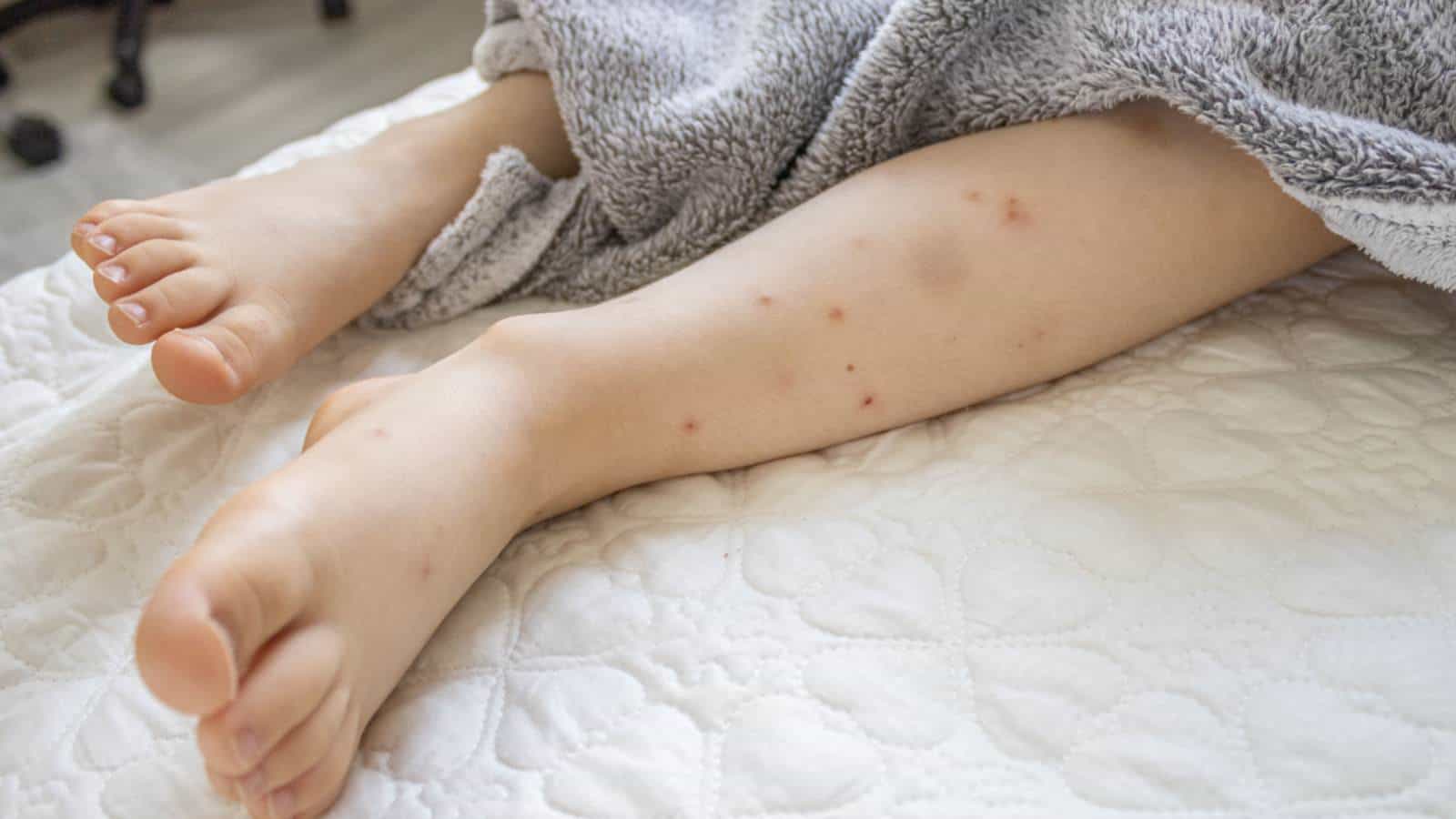
6. Bed Bug Rash on Dog
While bed bugs primarily feed on humans, they can occasionally bite pets.
On a dog, bed bug bites might appear as small, raised, reddish bumps on the skin. Dogs may exhibit signs of itching and discomfort if bitten by bed bugs.
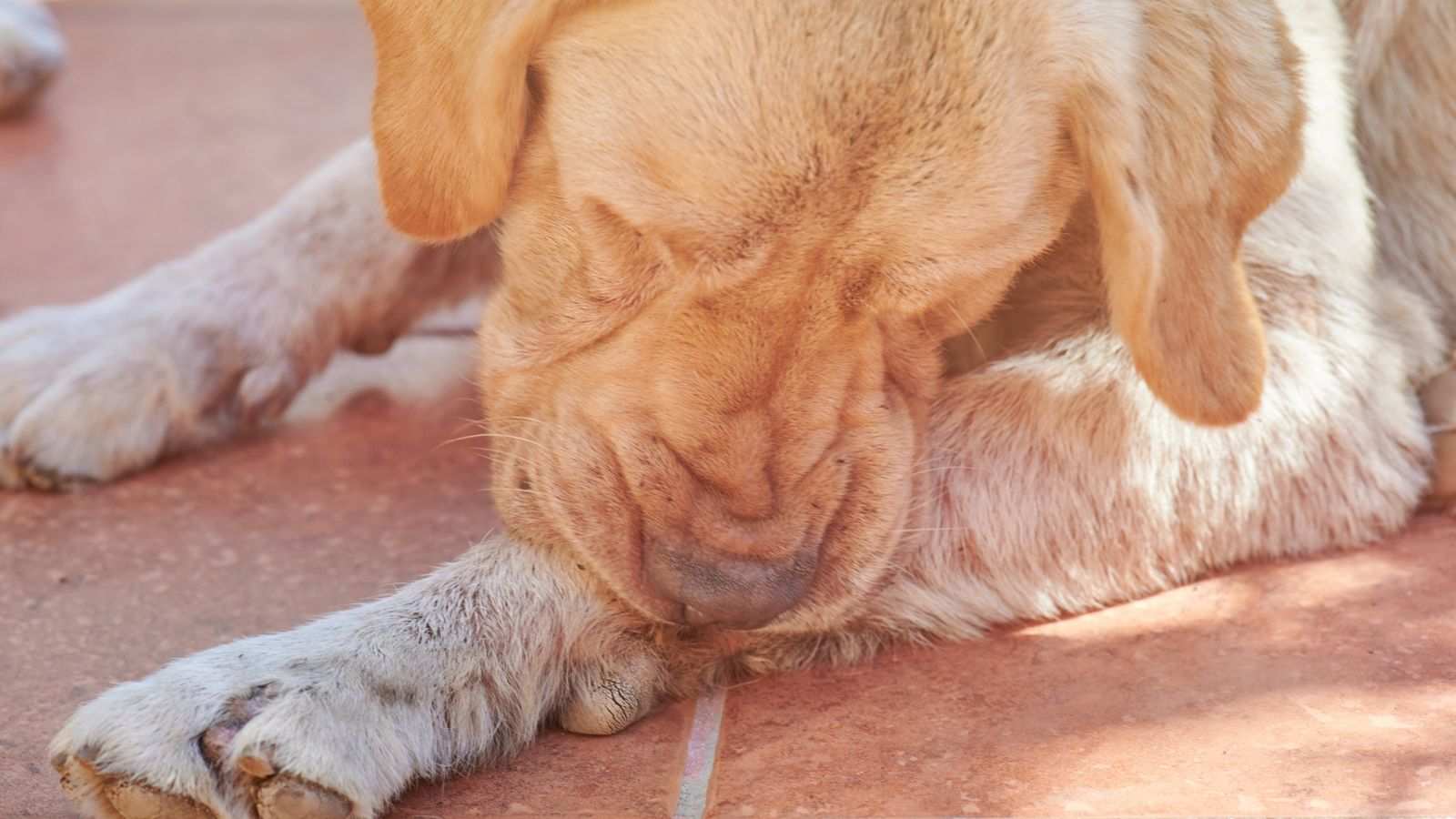
Bed Bug Bite Images vs. Other Insect Bites
Let’s also look at some common insect bites and how they compare to bed bug bites.
1. Bed Bug Bites vs. Flea Bites
Bed bug bites often appear as small, raised, and red or pinkish welts on the skin.
Flea bites, on the other hand, are usually smaller and characterized by a tiny, red dot with a single puncture mark in the center.
Bed bug bites tend to be more clustered and may form a line, a zigzag pattern, or a group of bumps, whereas flea bites can occur in various random patterns.

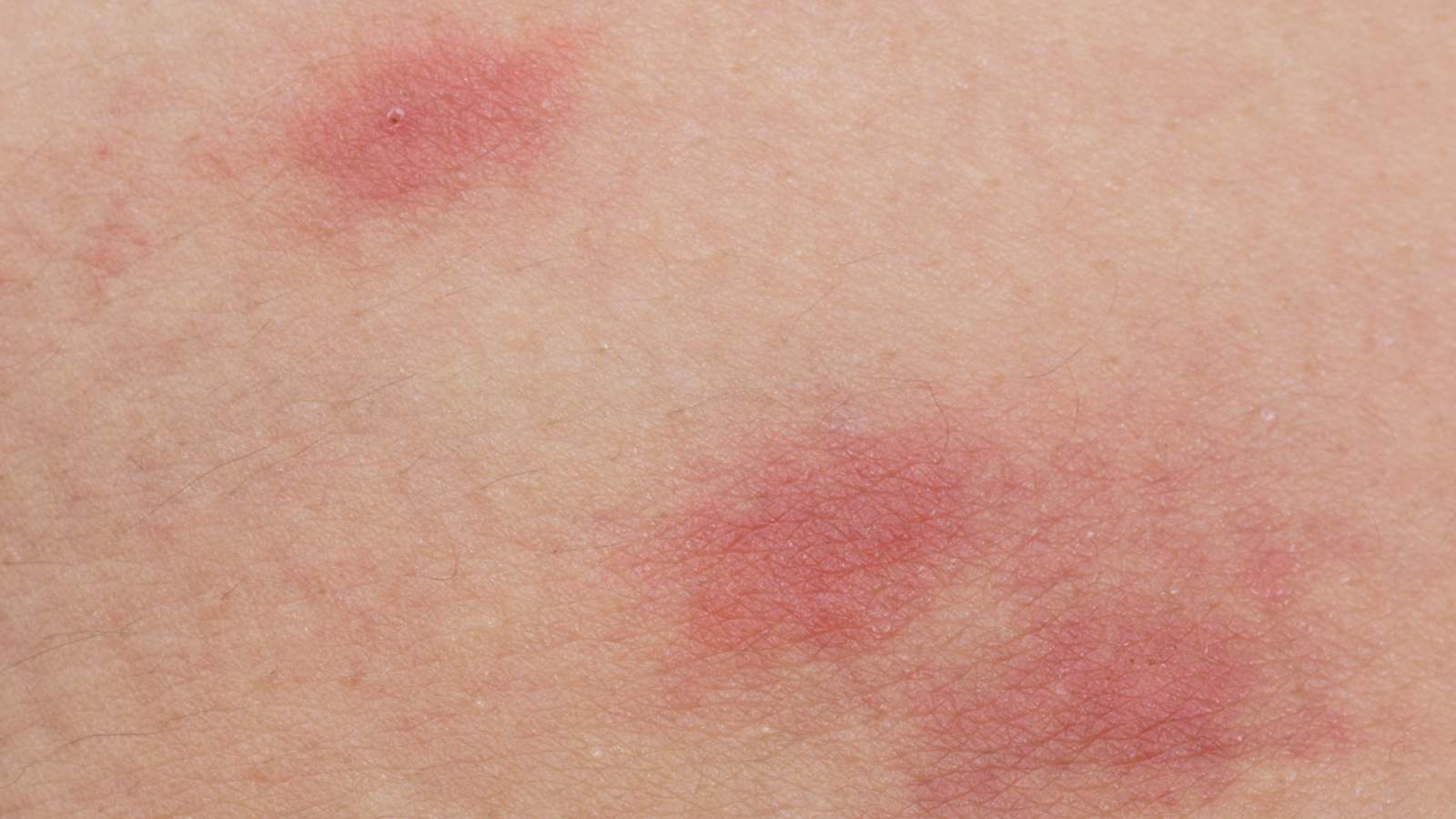
2. Bed Bug Bites vs. Mosquito Bites
Bed bug bites typically form clusters or lines of small, itchy red welts on the skin.
Mosquito bites often appear as individual, round, red bumps with a central puncture point.
Bed bug bites can be grouped closely together in one area, whereas mosquito bites are usually scattered randomly across the body.
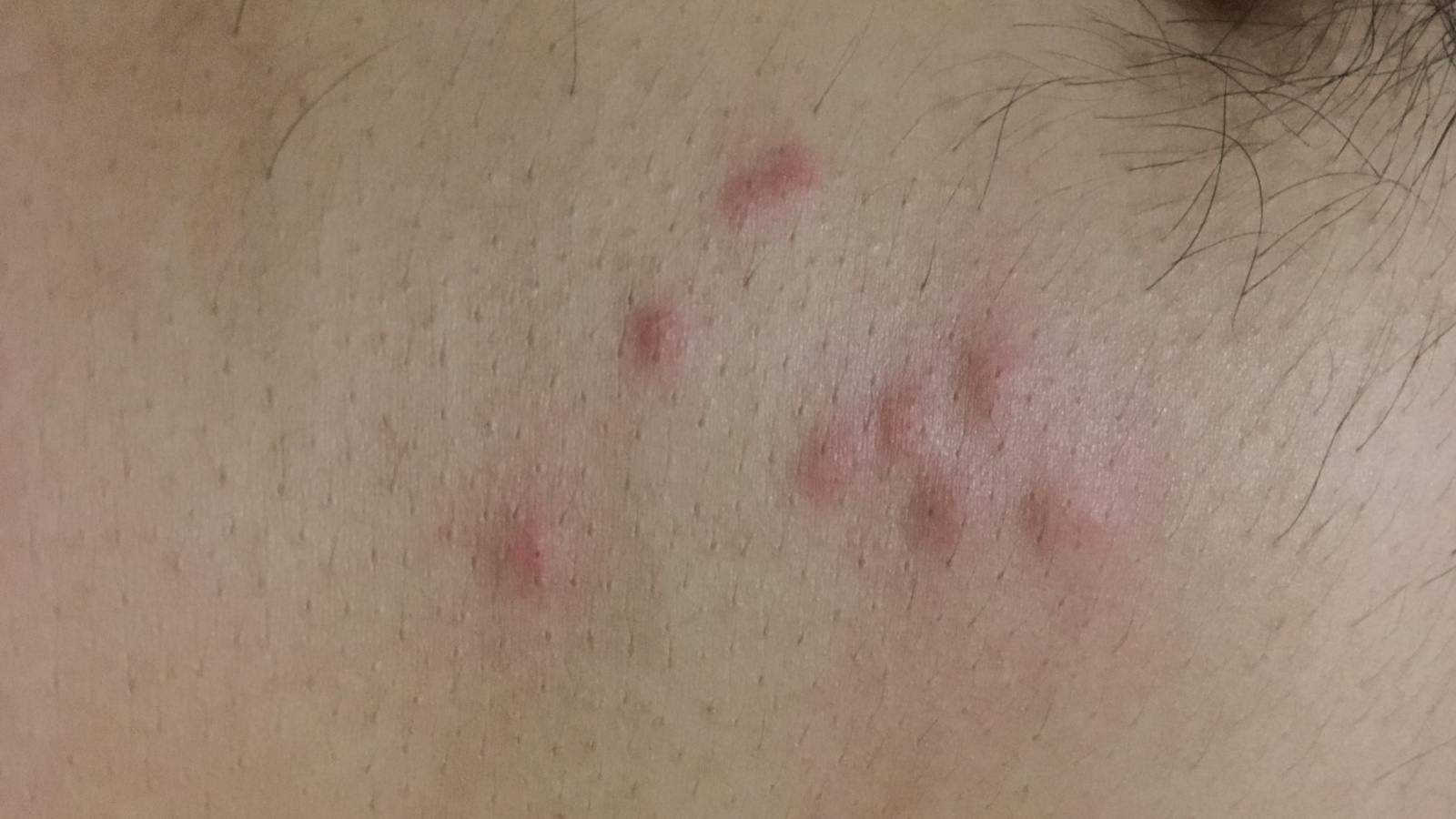
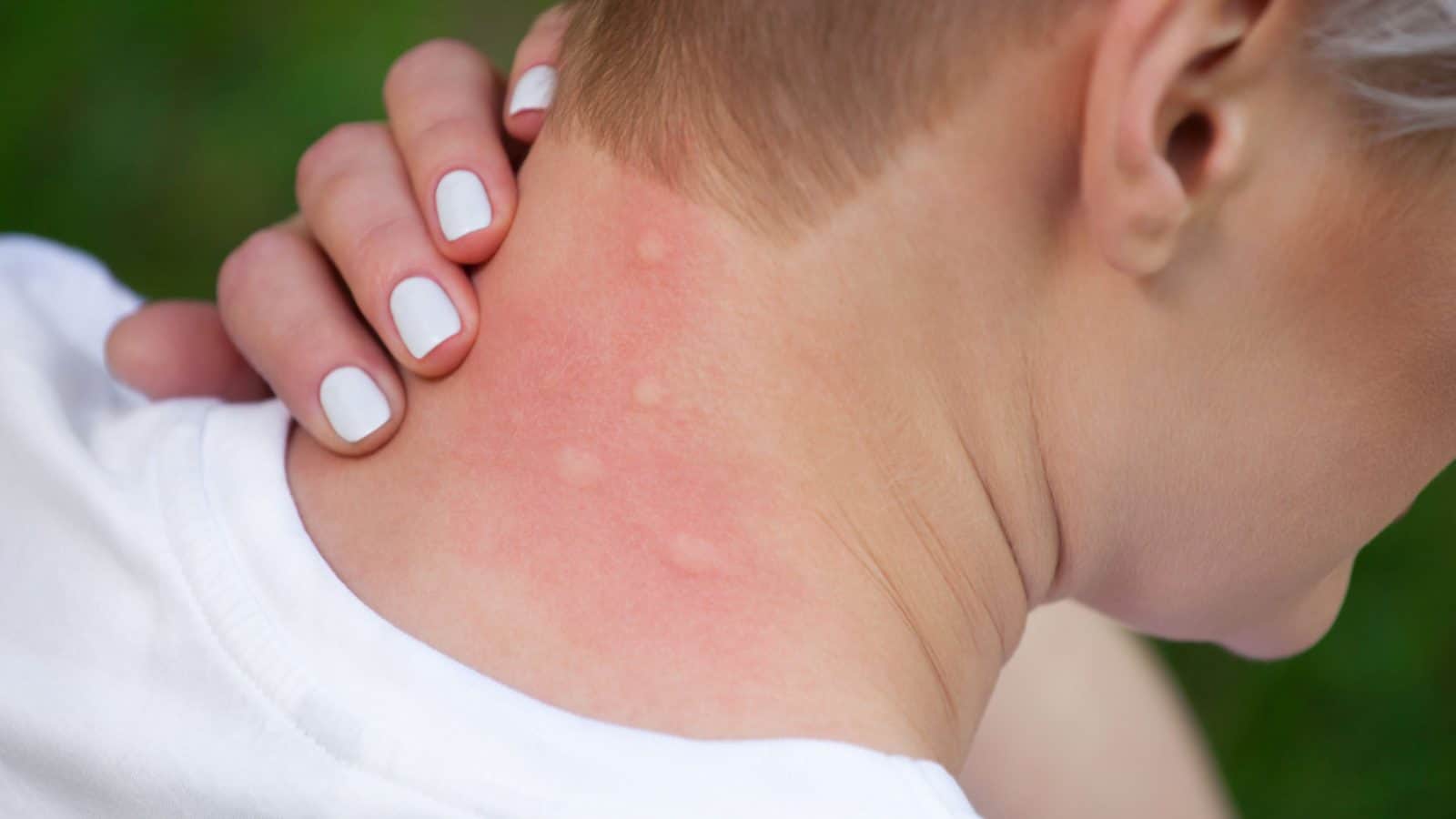
3. Bed Bug Bites vs. Tick Bites
Bed bug bites are generally small, red, and raised welts, often occurring in groups or in a zigzag pattern.
Tick bites can vary depending on the type of tick but often resemble a red, inflamed area with a central puncture where the tick was attached.
Bed bug bites are more likely to form clusters or lines, while tick bites can be solitary or occur in pairs.
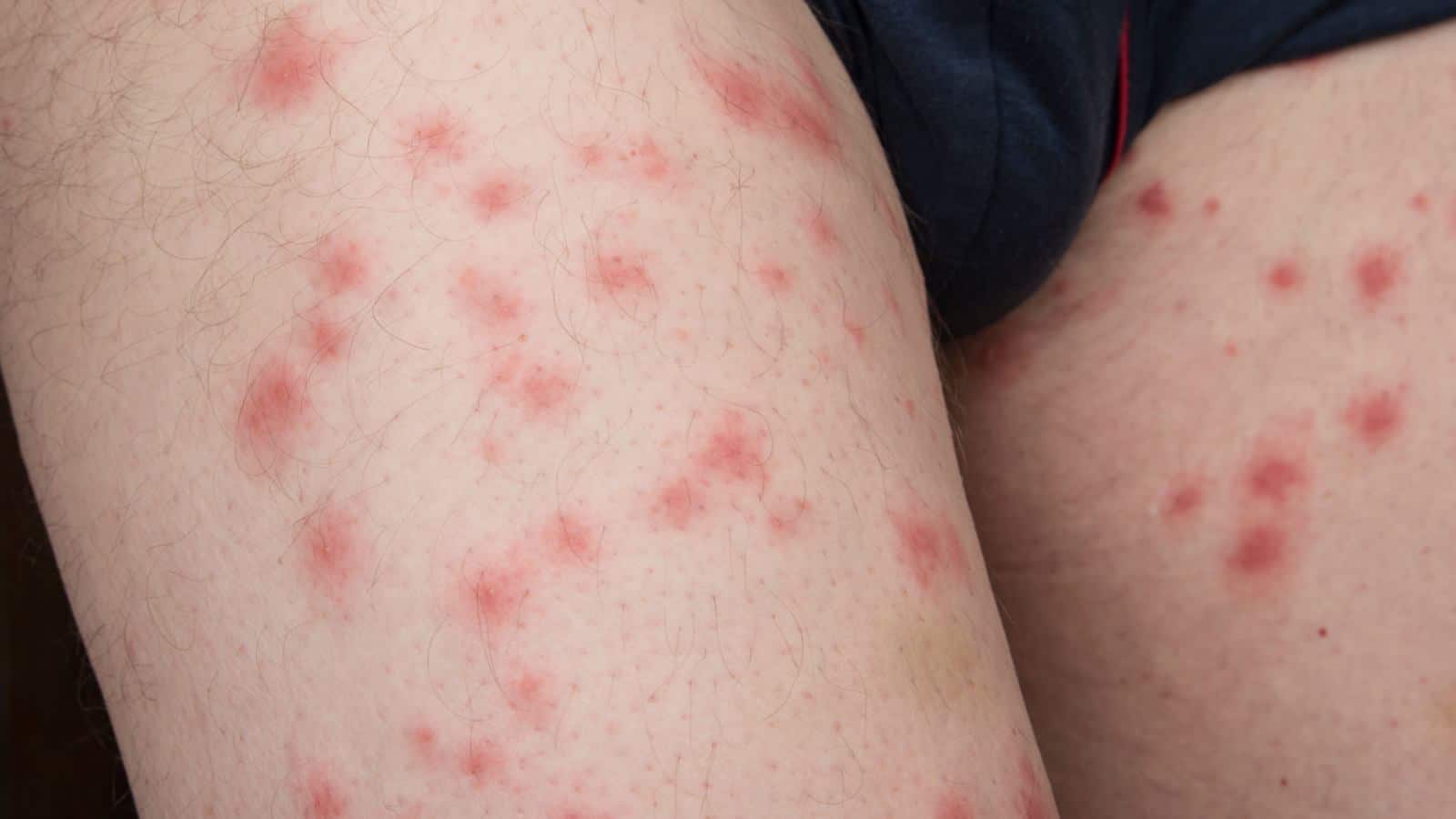
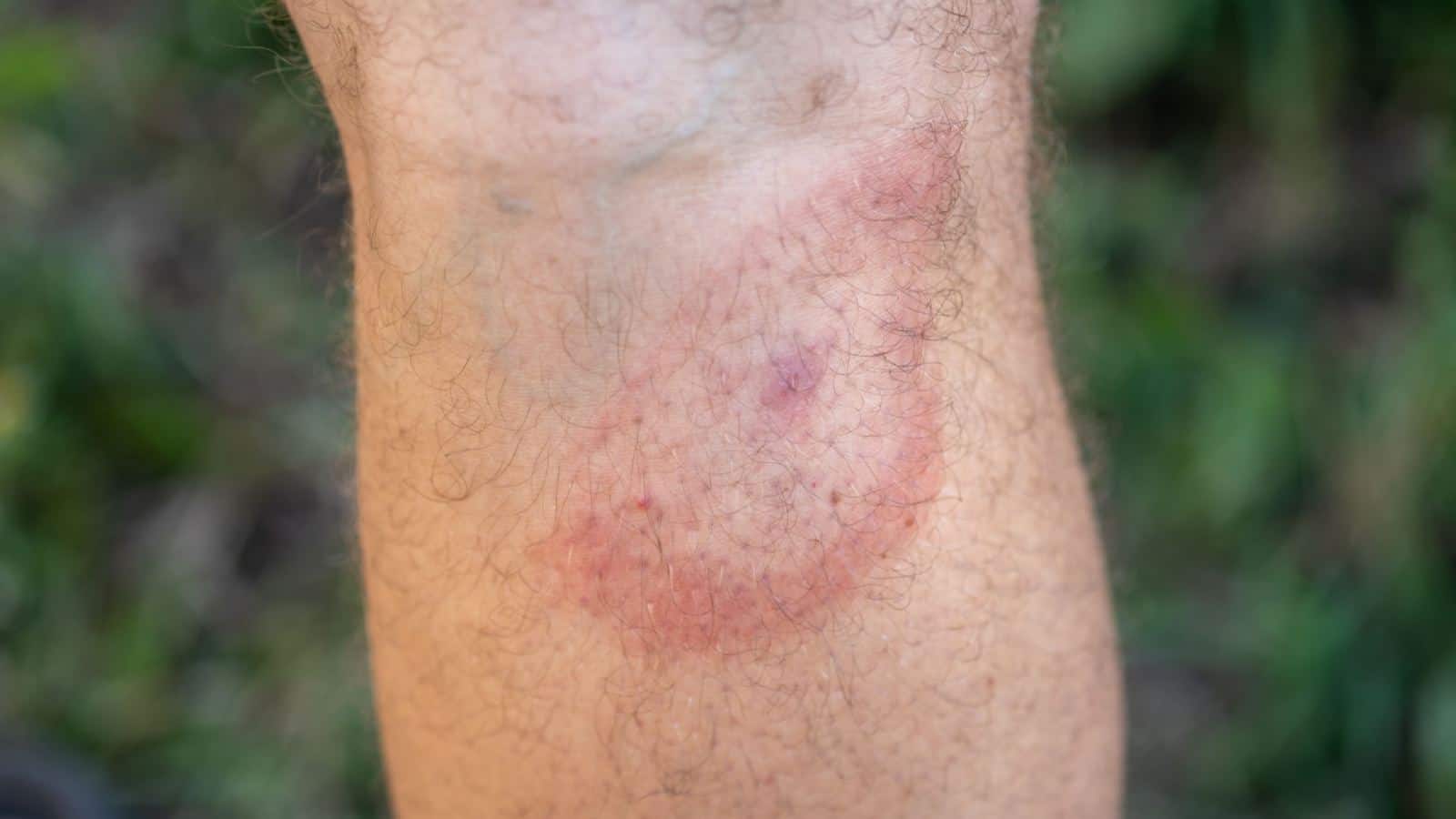
4. Bed Bug Bites vs. Spider Bites
Bed bug bites usually manifest as small, red, itchy welts in clusters or lines on the skin.
Spider bites can vary widely depending on the spider species, but they often have a central puncture or blister surrounded by redness.
Bed bug bites tend to be more uniform in appearance and are less likely to have a central blister.

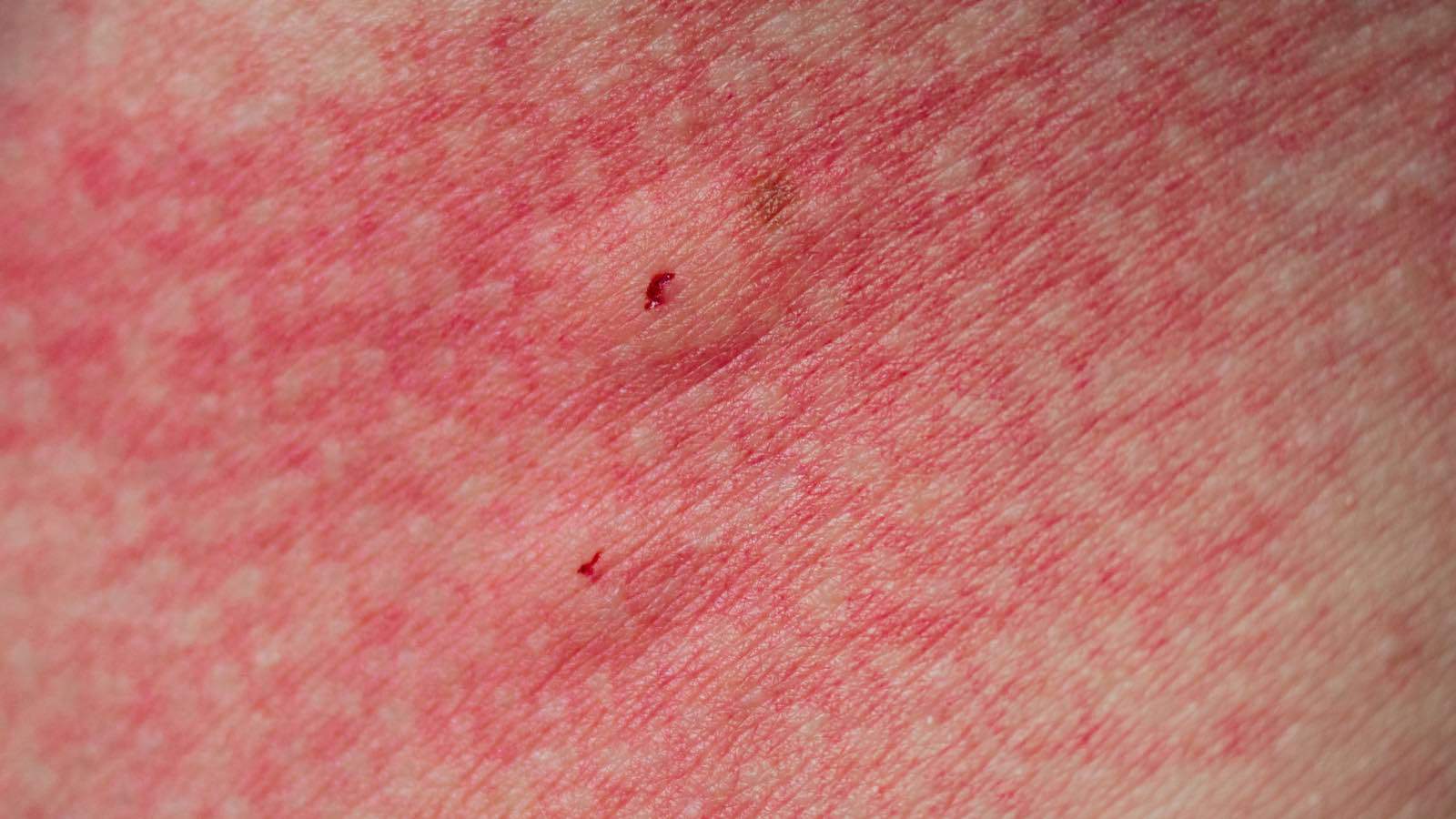
5. Bed Bug Bites vs. Chigger Bites
Bed bug bites are typically itchy bites and often form clusters or a zigzag pattern.
Chigger bites usually appear as intensely itchy, red, raised bumps with a central, fluid-filled blister.
Bed bug bites are often grouped together, while chigger bites can be scattered but are extremely itchy.


6. Bed Bug Bites vs. Hives
Bed bug bites are localized to the site of the bite and appear as small, raised red welts.
Hives (urticaria) are a generalized skin reaction that results in red, swollen, and itchy patches or welts on various parts of the body.
Bed bug bites are typically confined to the area where the bugs fed, while hives can appear anywhere on the body and are usually associated with an allergic reaction or trigger.


And there you have it: bed bug pictures and images to help you identify them more easily. Make sure to also check out the 8 most common bugs that look like bed bugs, and to bookmark this page so that you can come back to it whenever you need! It truly is the ultimate bed bug image guide!
Other Bed Bug Guides from Planet Natural:
The 11 Best Bed Bug Spray of 2023 (And What to Look For)
What Kills Bed Bugs Instantly? (The Complete Guide for 2023)
What Causes Bed Bugs? (Top 7 Causes of Bed Bug Infestations)
How to Get Rid of Bed Bugs on Mattress: Proven Solutions
Bed Bug Bites: Pictures, Symptoms, Treatment, and Prevention
What Do Bed Bug Eggs Look Like? Complete Guide with Pictures
Baby Bed Bugs: How to Identify & Get Rid of Them – Photos + FAQ
Complete Guide to Bed Bug Traps (+ 3 Best Ones in 2023!)
How to Get Rid of Bed Bugs: A Complete 7-Step Guide

